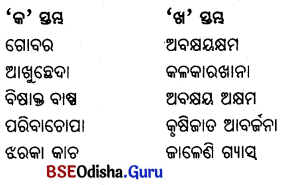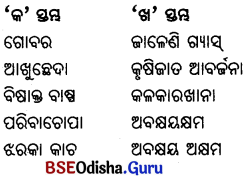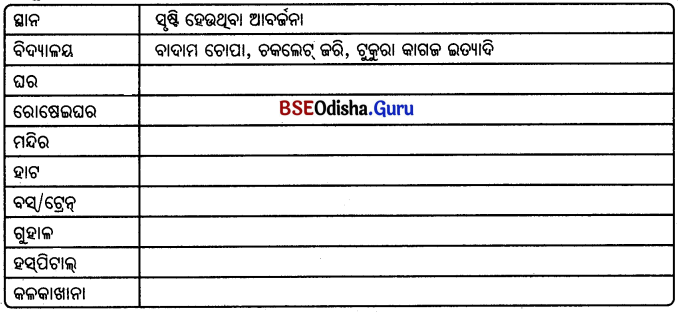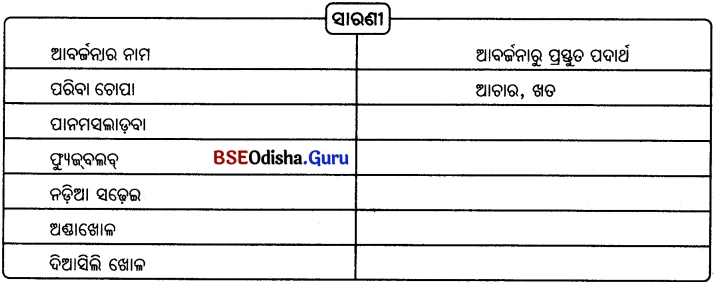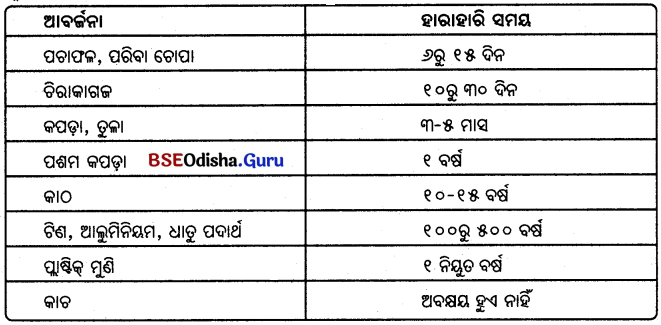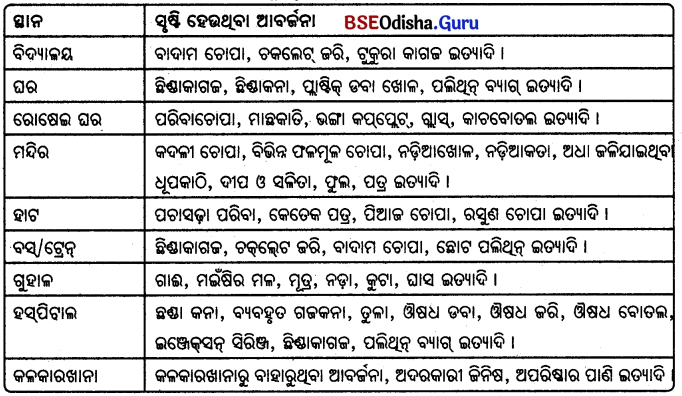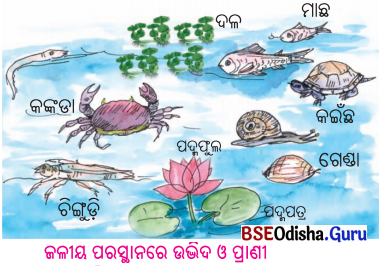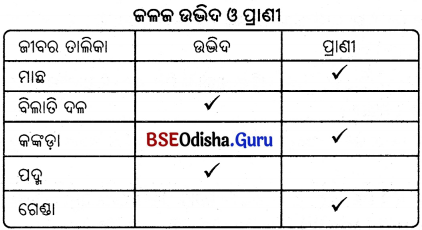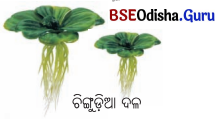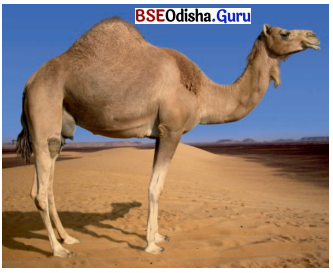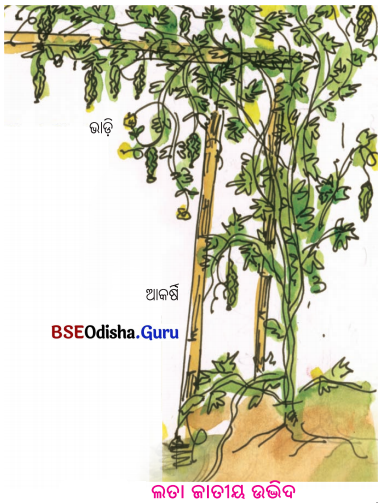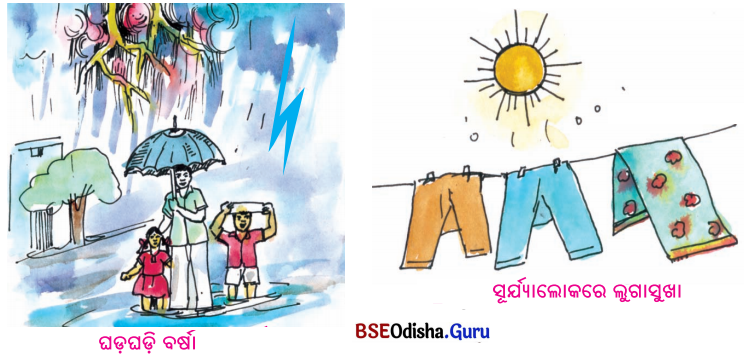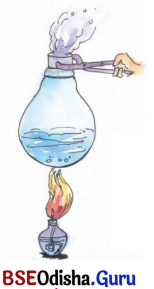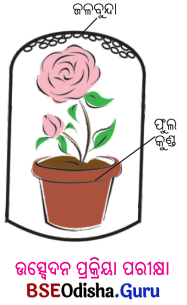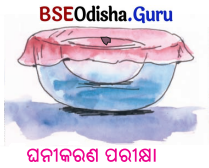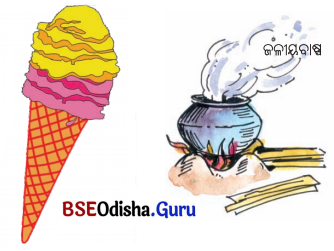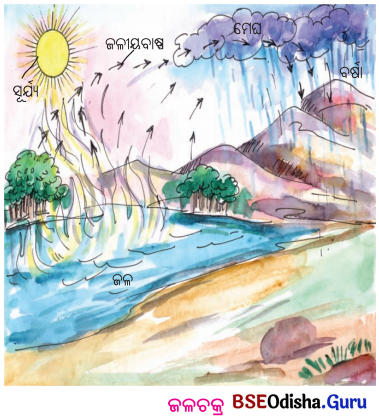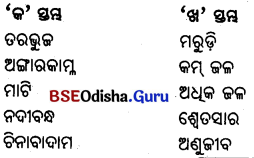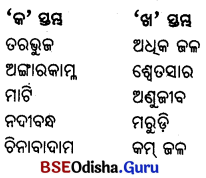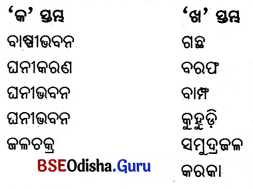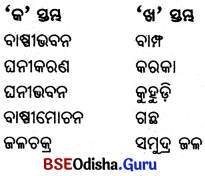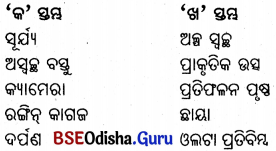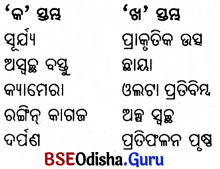Odisha State Board CHSE Odisha Class 11 Odia Solutions Chapter 3 ମଧୁବାବୁ Textbook Exercise Questions and Answers.
CHSE Odisha Class 11 Odia Chapter 3 ମଧୁବାବୁ Question Answer
ପାଠ୍ୟପୁସୃଜମ ପ୍ତଖାବଲାଭ ଇଉର :
Question 1.
ପ୍ରଶ୍ନର ମୂଲ୍ୟ ୧ ନମ୍ବର । ଚାରିଗୋଟି ସମ୍ଭାବ୍ୟ ଉତ୍ତର ମଧ୍ୟରୁ ଠିକ୍ ଉତ୍ତର ବାଛି ଲେଖ ।
(କ) ଚଉଧୁରୀ ରଘୁନାଥ ଦାସଙ୍କ ଜ୍ୟେଷ୍ଠପୁତ୍ରର ନାମ କ’ଣ ? (ଗୋପାଳବଲ୍ଲଭ, ରାଧାବଲ୍ଲଭ, ଉମାବଲ୍ଲଭ, ଗୋବିନ୍ଦବଲ୍ଲଭ)
Solution:
ଗୋବିନ୍ଦବଲ୍ଲଭ ।
(ଖ) ‘ଭୀମଭୂୟାଁ’ ଉପନ୍ୟାସର ଲେଖକ କିଏ ? (ଗୋବିନ୍ଦବଲ୍ଲଭ, ଗୋପାଳବଲ୍ଲଭ, ମଧୁସୂଦନ, କାହ୍ନୁ ଚରଣ )
Solution:
ଗୋପାଳବଲ୍ଲଭ |
(ଗ) ଏମାନଙ୍କ ମଧ୍ୟରୁ କେଉଁଟି ପାଠଶାଳାରେ ଉପରବେଳା ପଢ଼ାହେଉ ନଥିଲା ? (ରାମାୟଣ, ମହାଭାରତ, ଭାଗବତ, ପଣିକିଆ)
Solution:
ପଣିକିଆ ।
(ଘ) କଲିକତାରେ ଗୋବିନ୍ଦବଲ୍ଲଭଙ୍କୁ ପ୍ରଥମେ କିଏ ଆଶ୍ରୟ ଦେଇଥିଲେ ? (ଅମ୍ବିକାପ୍ରସାଦ, ବଙ୍କିମଚନ୍ଦ୍ର, ଶରତଚନ୍ଦ୍ର, ରବୀନ୍ଦ୍ରନାଥ )
Solution:
ଅମ୍ବିକାପ୍ରସାଦ ।

(ଙ) ଲର୍ଡ଼ କର୍ଜନଙ୍କ ଆଦେଶରେ ନିମ୍ନୋକ୍ତ କେଉଁ ଅଞ୍ଚଳଟିକୁ ଓଡ଼ିଶାରେ ମିଶାଇ ଦିଆଗଲା ? (ରାୟପୁର, ବିଳାସପୁର, ଜୟପୁର, ସମ୍ବଲପୁର)
Solution:
ସମ୍ବଲପୁର |
(ଚ) ମଧୁସୂଦନ ଜୀବନର ମଧ୍ୟାହ୍ନରେ କେତେଥର ବିଲାତଗସ୍ତ କରିଥିଲେ ?(ଥରେ, ଦୁଇଥର, ତିନିଥର, ଚାରିଥର)
Solution:
ଦୁଇଥର ।
(ଛ) କେଉଁ ମସିହାରେ ଭାରତରେ ମନ୍ତ୍ରୀଶାସନ ପ୍ରତିଷ୍ଠିତ ହେଲା ? (୧୯୨୦, ୧୯୨୧, ୧୯୨୨, ୧୯୨୩)
Solution:
୧୯୨୧।
(ଜ) କଲିକତାରେ କେଉଁ କଲେଜରେ ମଧୁସୂଦନ ଅଧ୍ୟାପନା କରୁଥିଲେ ? (ଚନ୍ଦନପୁର, ଜଗଦଳପୁର, ଶ୍ରୀରାମପୁର, ଚକ୍ରଧରପୁର )
Solution:
ଶ୍ରୀରାମପୁର ।
(ଝ) କିଏ ଓଡ଼ିଶାର ପ୍ରଥମ ଗଭର୍ଣ୍ଣର ? (ଜନ୍ ଉଡ଼ରଫ୍, ଜନ୍ ହବାକ୍, ମିଷ୍ଟର ଇଭାନ୍ସ୍, ଜନ୍ ବୀମ୍ସ୍)
Solution:
ଜନ୍ ହବାକ୍ ।
(ଞ) ମଧୁସୂଦନ ଦାସଙ୍କ ଶ୍ରାଦ୍ଧ ଦିବସ କେବେ ପାଳନ କରାଯାଏ ? (ଜାନୁଆରୀ ୨୮, ଫେବୃୟାରୀ ୪, ମାର୍ଚ୍ଚ ୨୪, ଏପ୍ରିଲ୍ ୨୮)
Solution:
ଫେବୃୟାରୀ ୪ ।
(ଟ) ମଧୁବାବୁ କେଉଁ ଧର୍ମ ଗ୍ରହଣ କରିଥିଲେ ? (ବ୍ରାହ୍ମଧର୍ମ, ମହିମାଧର୍ମ, ଖ୍ରୀଷ୍ଟଧର୍ମ, ଇସଲାମଧର୍ମ)
Solution:
ଖ୍ରୀଷ୍ଟଧର୍ମ ।
Question 2.
ଗୋଟିଏ ବାକ୍ୟରେ ଉତ୍ତର ଲେଖ । ପ୍ରଶ୍ନର ମୂଲ୍ୟ ୧ ନମ୍ବର।
(କ) କେଉଁ ମହାପୁରୁଷଙ୍କ ଜୀବନକାହାଣୀ ଉତ୍କଳର ଅର୍ଦ୍ଧଶତାବ୍ଦୀର ଇତିହାସ ?
Solution:
ମଧ୍ନବାରୁ ଜୀବନକାହାଣୀ ଉତ୍କଳର ଅର୍ଦ୍ଧଶତାବ୍ଦୀର ଇତିହାସ |
(ଖ) ମଧୁବାବୁ ଉତ୍କଳର ଘରେ ଘରେ କେଉଁ ନାମରେ ପରିଚିତ ?
Solution:
ମଧୁବାବୁ ଉତ୍କଳର ଘରେ ଘରେ ମଧ୍ନବାରିକର ନାମରେ ପରିଚିତ |
(ଗ) ମଧୁସୂଦନ କେଉଁଥିପାଇଁ ନିରନ୍ତର ବ୍ୟାକୁଳ ଥିଲେ ?
Solution:
ମଧୁସୂଦନ ଦେଶର, ଜାତିର ସର୍ବବିଧ ଉନ୍ନତି ପାଇଁ ନିରନ୍ତର ବ୍ୟାକୁଳ ଥିଲେ ।
(ଘ) ମଧୁସୂଦନଙ୍କ ଜୀବନର ଚିରଲକ୍ଷ୍ୟ କ’ଣ ଥିଲା ?
Solution:
ଓଡ଼ିଆ କିପରି ଓଡ଼ିଶା ବାହାରେ ଦେଶବିଦେଶରେ ସମ୍ମାନୀତ ହେବେ ଏହାହିଁ ମଧୁସୂଦନଙ୍କ ଜୀବନର ଚିର ଲକ୍ଷ୍ୟ ଥିଲା ।
(ଙ) ମୃତ୍ୟୁଶଯ୍ୟାରେ ମଧ୍ୟ କେଉଁ କଥା ମଧୁସୂଦନଙ୍କର ଏକମାତ୍ର ଚିନ୍ତା ଥିଲା ?
Solution:
ମୃତ୍ୟୁଶଯ୍ୟାରେ ମଧ୍ୟ ଓଡ଼ିଆର ଉନ୍ନତି ମଧୁସୂଦନଙ୍କର ଏକମାତ୍ର ଚିନ୍ତା ଥିଲା ।
(ଚ) କେଉଁ ଗ୍ରାମକୁ ପ୍ରତ୍ୟେକ ଓଡ଼ିଆର ତୀର୍ଥସ୍ଥାନ୍ ବୋଲି କୁହାଯାଇଛି ?
Solution:
ସତ୍ୟଭାମାପୁର ଗ୍ରାମକୁ ପ୍ରତ୍ୟେକ ଓଡ଼ିଆର ତୀର୍ଥସ୍ଥାନ ବୋଲି କୁହାଯାଇଛି ।
(ଛ) ମଧୁବାବୁଙ୍କ ପିତା, ମାତାଙ୍କ ନାମ କ’ଣ ?
Solution:
ମଧୁସୂଦନଙ୍କ ପିତାଙ୍କ ନାମ ଚଉଧୁରୀ ରଘୁନାଥ ଦାସ, ମାତାଙ୍କ ନାମ ଶ୍ରୀମତୀ ପାର୍ବତୀଦେବୀ ।
(ଜ) ମଧୁବାବୁଙ୍କ ପିତୃମାତୃଦତ୍ତ ନାମ କ’ଣ ଥିଲା ?
Solution:
ମଧୁବାବୁଙ୍କ ପିତୃମାତୃଦତ୍ତ ନାମ ରେବିନ୍ଦବଲ୍ଲଭ କ’ଣ ଥିଲା |

(ଝ) ମଧୁସୂଦନଙ୍କ ସାନଭାଇର ନାମ କ’ଣ ଥିଲା ?
Solution:
ମଧୁସୂଦନଙ୍କ ସାନଭାଇର ନାମ ଗୋପାଲବଲ୍ଲଭ ଥିଲା |
(ଟ) ପ୍ରାଚୀନ ଓଡ଼ିଶାରେ ବଂଶ ପରମ୍ପରା କ୍ରମେ କେଉଁମାନେ ପ୍ରାଥମିକ ଶିକ୍ଷାଭାର ଗ୍ରହଣ କରୁଥିଲେ ?
Solution:
ପ୍ରାଚୀନ ଓଡ଼ିଶାର ବଂଶ ପରମ୍ପରାକ୍ରମେ ମାଟିବଂଶ ବା କ୍ଷତିବଂଶ ଅବଧାନମାନେ ପ୍ରାଥମିକ ଶିକ୍ଷାଭାର ଗ୍ରହଣ କରୁଥିଲେ |
(୦) ସ୍ଥାନ ବିଶେଷରେ ଅବଧାନମାନଙ୍କୁ କ’ଣ କହନ୍ତି ?
Solution:
ସ୍ଥାନ ବିଶେଷରେ ଅବଧାନମାନଙ୍କୁ ଓଝା କହନ୍ତି ।
(ଉ) ଆଗେ କେଉଁଠାରେ ଗାଁ ପାଠଶାଳା ବସୁଥୁଲା ?
Solution:
ଗାଁରେ ଖଣ୍ଡେ ଚାଳିଘରେ, ଶୀତଦିନେ ଆମ୍ବ ବା ବରଗଛମୂଳେ ଗାଁ ପାଠଶାଳା ବସୁଥିଲା ।
(ଢ) ପିଲାମାନେ ଭୂମିରେ କେଉଁ ଖଡ଼ିରେ ଲେଖୁଥିଲେ ?
Solution:
ପିଲାମାନେ ଭୂମିରେ ଶୁଆପଞ୍ଝା ଖଡ଼ିରେ ଲେଖୁଥିଲେ ।
(ଣ) ପିଲାମାନେ କେଉଁଥିରେ ହସ୍ତାକ୍ଷର ମଡ଼ାଉଥିଲେ ?
Solution:
ପିଲାମାନେ ତାଳପତ୍ର ଓ ଲେଖନରେ ହସ୍ତାକ୍ଷର ମଡ଼ାଉଥିଲେ ।
(ତ) ଛାତ୍ରମାନଙ୍କୁ ପ୍ରତ୍ୟୁଷରୁ ଉଠିବାପାଇଁ ଅବଧାନଙ୍କର କେଉଁ ବ୍ୟବସ୍ଥା ଥିଲା ?
Solution:
ଛାତ୍ରମାନଙ୍କୁ ପ୍ରତ୍ୟୁଷରୁ ଉଠିବାପାଇଁ ଅବଧାନଙ୍କର ‘ଣ୍ମନଦେବା’ ବ୍ୟବସ୍ଥା ଥିଲା |
(ଥ) ପ୍ରଥମେ ଚାଟଶାଳୀକୁ ଆସି କ’ଣ କରିବାକୁ ପିଲାମାନଙ୍କ ମଧ୍ୟରେ ପ୍ରତିଦ୍ବନ୍ଦିତା ଥିଲା ?
Solution:
ପ୍ରଥମେ ଚାଟଶାଳୀକୁ ଆସି ଥତଧାନକୁ ପ୍ରଣାମ କରିବାକୁ ପିଲାମାନଙ୍କ ମଧ୍ୟରେ ପ୍ରତିଦ୍ବନ୍ଦିତା ଥିଲା |
(ଦ) ଚାଟଶାଳୀରେ ସନ୍ଧ୍ୟାବେଳେ କେଉଁ ଶ୍ଳୋକ ଆବୃତ୍ତି କରାଯାଉଥିଲା ?
Solution:
ଚାଟଶାଳୀରେ ସନ୍ଧ୍ୟାବେଳେ ଚାଣକ୍ୟ କେଉଁ ଶ୍ଳୋକ ଆବୃତ୍ତି କରାଯାଉଥିଲା |
(ଧ) ଚାଟଶାଳୀରେ କେତେବେଳେ ମାନସାଙ୍କ ପଚରା ଯାଉଥିଲା ?
Solution:
ଚାଟଶାଳୀରେ ସନ୍ଧ୍ୟାବେଳେ ମାନସାଙ୍କ ପଚରା ଯାଉଥିଲା |
(ନ) ମଧୁବାବୁ କେତେବର୍ଷ ବୟସରେ କଟକ ଆସିଥିଲେ ?
Solution:
ମଧୁବାବୁ ତେରବଶ ବୟସରେ କଟକ ଆସିଥିଲେ |
(ପ) ମଧୁବାବୁ କଟକର ଇଂରାଜୀ ବିଦ୍ୟାଳୟରେ ପଢ଼ିବାପାଇଁ କିଏ ଆପରି କରିଥିଲେ ?
Solution:
ମଧୁବାବୁ କଟକର ଇଂରାଜୀ ବିଦ୍ୟାଳୟରେ ପଢ଼ିବାପାଇଁ ପିତାମହୀ ଆପରି କରିଥିଲେ ।
(ଫ) ମଧୁସୂଦନଙ୍କ ପିତାମହୀଙ୍କର କ’ଣ ଆଶଙ୍କା ଥିଲା ?
Solution:
ମଧୁସୂଦନଙ୍କ ପିତାମହୀଙ୍କର ଇଂରାଜୀ ପଢ଼ିଲେ ଖ୍ରୀଷ୍ଟିୟାନ ହୋଇଯିବ ବୋଲି ଆଶଙ୍କା ଥିଲା ।
(ବି) କଟକରେ ଉଚ୍ଚ ଇଂରାଜୀ ବିଦ୍ୟାଳୟ ପରେ କେଉଁ ନାମରେ ନାମିତ ହୋଇଥିଲା ?
Solution:
କଟକରେ ଉଚ୍ଚ ଇଂରାଜୀ ବିଦ୍ୟାଳୟ ପରେ ରେଭେନ୍ସା କଲେଜିଏଟ୍ ସ୍କୁଲ ନାମରେ ନାମିତ ହୋଇଥିଲା ।
(ଭ) ଗୋବିନ୍ଦବଲ୍ଲଭ କଟକ ହାଇସ୍କୁଲରୁ ଏଣ୍ଟ୍ରାନ୍ସ ପାଶ୍ କରି କେଉଁଠାରେ କେଉଁ କାମରେ ନିଯୁକ୍ତ ହୋଇଥିଲେ ?
Solution:
ଗୋବିନ୍ଦବଲ୍ଲଭ କଟକ ହାଇସ୍କୁଲରୁ ଏଣ୍ଟ୍ରାନ୍ସ ପାର୍ଶ୍ଵକରି ବାଲେଶ୍ଵରରେ କିରାନୀ କାମରେ ନିଯୁକ୍ତ ହୋଇଥିଲେ ।
(ମ) ଆଗେ ଚାନ୍ଦବାଲିଠାରୁ ଲୋକେ କିପରି କଲିକତା ଯାଉଥିଲେ ?
Solution:
ଆଗେ ଚାନ୍ଦବାଲିଠାରୁ ଲୋକେ ଷ୍ଟିମର ବା ଧୂଆଁକଳଚାଳିତ ନୌକାରେ କଲିକତା ଯାଉଥିଲେ ।
(ଯ) କଲିକତାରେ ଗୋବିନ୍ଦବଲ୍ଲଭଙ୍କର କାହା ସହିତ ପରିଚିତ ହେଲା ?
Solution:
କଲିକତାରେ ଗୋବିନ୍ଦବଲ୍ଲଭଙ୍କର ଅମ୍ବିକାପ୍ରସାଦ ହାଜରାଙ୍କ ସହିତ ପରିଚିତ ହେଲା ।
(ର) ଗୋବିନ୍ଦବଲ୍ଲଭ କେଉଁ ବିଷୟରେ ଏମ୍.ଏ.ପାଶ କରିଥିଲେ ?
Solution:
ଗୋବିନ୍ଦବଲ୍ଲଭ ଇଂରାଜୀ ସାହିତ୍ୟରେ ଏମ୍.ଏ.ପାଶ କରିଥିଲେ ।
(ଳ) ମଧୁବାବୁ ପ୍ରଥମେ କଲିକତାର କେଉଁ ସ୍କୁଲରେ ଶିକ୍ଷାଦାନ କରୁଥିଲେ ?
Solution:
ମଧୁବାବୁ ପ୍ରଥମେ କଲିକତାର ବିଭିନ୍ନ ୍କୁଲରେ ଶିକ୍ଷାଦାନ କରୁଥିଲେ |
(ବି) ଶେଷରେ ମଧୁବାବୁ କେଉଁ କଲେଜରେ ଅଧ୍ୟାପକ ହେବାପାଇଁ ପ୍ରାର୍ଥୀ ହୋଇଥିଲେ ?
Solution:
ଶେଷରେ ମଧୁବାବୁ ଶ୍ରାରାମପୂର କଲେଜରେ ଅଧ୍ୟାପକ ହେବାପାଇଁ ପ୍ରାର୍ଥୀ ହୋଇଥିଲେ |
(ଶ) ଶ୍ରୀରାମପୁର କଲେଜର ଅଧ୍ୟକ୍ଷ ମଧୁବାବୁଙ୍କୁ ଡାକି କ’ଣ ପଚାରିଲେ ?
Solution:
ଶ୍ରୀରାମପୁର କଲେଜର ଅଧ୍ୟକ୍ଷ ମଧୁବାବୁଙ୍କ ଡାକି, ‘ଆପଣ କେଉଁ ବିଷୟ ପଢ଼ାଇ ପାରିବେ’ ବୋଲି ପଚାରିଲେ ।
(ଷ) ମଧୁବାବୁ ଶ୍ରୀରାମପୁର କଲେଜରେ ଛାତ୍ରମାନଙ୍କୁ କେଉଁ ବିଷୟ ପ୍ରାଞ୍ଜଳ ଭାବରେ ପଢ଼ାଇ କ’ଣ ହୋଇପାରିଥିଲେ ?
Solution:
ମଧୁବାବୁ ଶ୍ରୀରାମପୁର କଲେଜରେ ଛାତ୍ରମାନଙ୍କୁ ପଢ଼ାଇ ଛାତ୍ରମାନଙ୍କ ଭକ୍ତିଭାଜନ ହୋଇଥିଲେ ।
(ସ) ଗୋବିନ୍ଦବଲ୍ଲଭ କେଉଁ ବିଶ୍ଵବିଦ୍ୟାଳୟରୁ ବି.ଏଲ୍. ପାଶ୍ କରିଥିଲେ ?
Solution:
ଗୋବିନ୍ଦବଲ୍ଲଭ କଲିକତା ବିଶ୍ବବିଦ୍ୟାଳୟରୁ ବି.ଏଲ୍.ପାଶ୍ କରିଥିଲେ ।
(ହ) ଗୋବିନ୍ଦବଲ୍ଲଭ କଲିକତାରେ ଶିକ୍ଷକତା କଲାବେଳେ କାହାର ଗୃହଶିକ୍ଷକ ରୂପେ ନିଯୁକ୍ତ ହୋଇଥିଲେ ?
Solution:
ଗୋବିନ୍ଦବଲ୍ଲଭ କଲିକତାରେ ଶିକ୍ଷକତା କଲାବେଳେ ଭାରତୀୟ ଗୁଣିଗଣାଗ୍ରଗଣ୍ୟ ସାର୍ ଆଶୁତୋଷ ମୁଖୋପାଧ୍ୟାୟଙ୍କ ଗୃହଶିକ୍ଷକ ରୂପେ ନିଯୁକ୍ତ ହୋଇଥିଲେ ।
(ୟ) ମଧୁସୂଦନ କେଉଁ କାଗଜପତ୍ରକୁ ଇଂରାଜୀରେ ଅନୁବାଦ କରୁଥିଲେ ?
Solution:
ମଧୁସୂଦନ କେଉଁ କାଗଜପତ୍ରକୁ ଇଂରାଜୀରେ ଅନୁବାଦ କରୁଥିଲେ |
(ଲ) ମଧୁସୂଦନ ଓଡ଼ିଆ କର୍ମୀମାନଙ୍କ ଶିକ୍ଷାର ବିସ୍ତାର ପାଇଁ କଲିକତାରେ କେଉଁ ବିଦ୍ୟାଳୟ ସ୍ଥାପନ କରିଥିଲେ ?
Solution:
ମଧୁସୂଦନ ଓଡ଼ିଆ କର୍ମୀମାନଙ୍କ ଶିକ୍ଷାର ବିସ୍ତାର ପାଇଁ କଲିକତାରେ ନୈଶ୍ୟ ବିଦ୍ୟାଳୟ ସ୍ଥାପନ କରିଥିଲେ ।

(8) କେଉଁ ରାଜାଙ୍କ ନାମରେ ଗୋଟିଏ ବର୍ଷ ଗଣନା ହୁଏ ?
Solution:
ପୁରୀର ଗଜଜପତି ମହାରାଜାଙ୍କ ନାମରେ ଗୋଟିଏ ବର୍ଷ ଗଣନା ହୁଏ ।
(i) ଓଡ଼ିଆଭାଷୀ ଅଞ୍ଚଳର ଏକତ୍ରୀକରଣର ପ୍ରଥମ ଉଦ୍ୟମ କ’ଣ ?
Solution:
ଓଡ଼ିଆଭାଷୀ ଅଞ୍ଚଳର ଏକତ୍ରୀକରଣର ପ୍ରଥମ ଉଦ୍ୟମ ଉତ୍କଳ ସମ୍ମିଳନୀର ପ୍ରତିଷ୍ଠା ।
(ii) ମଧୁସୂଦନ ସ୍ଥାପନ କରିଥିବା ଜୋତା କାରଖାନାର ନାମ କ’ଣ ?
Solution:
ମଧୁସୂଦନ ସ୍ଥାପନ କରିଥିବା ଜୋତା କାରଖାନାର ନାମ ଭକୃଳ ଟାନେରା |
(iii) ମଧୁସୂଦନ ଜୀବନର ମଧ୍ୟାହ୍ନରେ କେତେଥର ବିଲାତ ଯାଇଥିଲେ ?
Solution:
ମଧୁସୂଦନ ଜୀବନର ମଧ୍ୟାହ୍ନରେ ଦୁଇଥର ବିଲାତ ଯାଇଥିଲେ ।
(iv) ମନ୍ତ୍ରୀ ଭାବରେ ମଧୁସୂଦନ ନିଜର କ’ଣ ବିକାଶ କରି ଯାଇଥିଲେ ।
Solution:
ମନ୍ତ୍ରୀ ଭାବରେ ମଧୁସୂଦନ ନିଜର ସ୍ଵାତନ୍ତ୍ର୍ୟ ଓ ଶକ୍ତିର ବିକାଶ କରି ଯାଇଥିଲେ ।
(v) ମଧୁସୂଦନ କେଉଁ ଭାଷାରେ ଜଣେ ତେଜସ୍ବୀ ବକ୍ତା ଥିଲେ ?
Solution:
ମଧୁସୂଦନ ଇଂରାଜୀ ଓ ଓଡ଼ିଆ ଭାଷାରେ ଜଣେ ଥିଲେ ବକ୍ତା ଥିଲେ ।
(vi) ମଧୁସୂଦନଙ୍କ ଜୀବନର ମୂଳମନ୍ତ୍ର କ’ଣ ଥିଲା ?
Solution:
ମଧୁସୂଦନଙ୍କ ଜୀବନର ମୂଳମନ୍ତ୍ର ଜାତି ସଙ୍ଗଠନ ଥିଲା ।
Question 3.
ଦୁଇଟି ବାକ୍ୟରେ ଉତ୍ତର ଲେଖ । ପ୍ରଶ୍ନର ମୂଲ୍ୟ ୨ ନମ୍ବର । ଲେଖା ଓ ଲେଖକଙ୍କ ସୂଚନା ପାଇଁ ୧ ନମ୍ବର ଏବଂ ଉତ୍ତର ପାଇଁ ୧ ନମ୍ବର ରହିବ ।
(କ) ମଧୁବାବୁଙ୍କ ଜୀବନ କାହାଣୀରେ ଉତ୍କଳର କେଉଁ ସମସ୍ତ ବିଷୟ ନିହିତ ରହିଅଛି ?
Solution:
‘ମଧୁବାବୁ’ ପ୍ରବନ୍ଧରେ ପ୍ରାବନ୍ଧିକ ଚିନ୍ତାମଣି ଆଚାର୍ଯ୍ୟ ଏହା ଉଲ୍ଲେଖ କରିଛନ୍ତି । ଇକ୍ରଲର ର୍ଥଦଣଡାଦାର ଲତିଦ୍ବାସ ନିହିତ ରତ୍ରିରଛି |
(ଖ) ମଧୁସୂଦନଙ୍କର ଚିରଲକ୍ଷ୍ୟ ଓ ଏକମାତ୍ର ଚିନ୍ତା କ’ଣ ଥିଲା ?
Solution:
‘ମଧୁବାବୁ’ ପ୍ରବନ୍ଧରେ ପ୍ରାବନ୍ଧିକ ଚିନ୍ତାମଣି ଆଚାର୍ଯ୍ୟ ଏହା ଉଲ୍ଲେଖ କରିଛନ୍ତି । ଏକମାତ୍ର ଚିନ୍ତା ଥୁଲା, ‘ଓଡ଼ିଆ କିପରି ଓଡ଼ିଶା ବାହାରେ ଦେଶ ବିଦେଶରେ ସମ୍ମାନୀତ ହେବେ ।’
(ଗ) ମଧୁବାବୁ କେବେ ଏବଂ କେଉଁଠାରେ ଜନ୍ମଗ୍ରହଣ କରିଥିଲେ ?
Solution:
‘ମଧୁବାବୁ’ ପ୍ରବନ୍ଧରେ ପ୍ରାବନ୍ଧିକ ଚିନ୍ତାମଣି ଆଚାର୍ଯ୍ୟ ଏହା ଉଲ୍ଲେଖ କରିଛନ୍ତି । ମଧୁବାବୁ ଖ୍ରୀଷ୍ଟୀୟ ୧୮୪୮ ଅବ୍ଦର ଏପ୍ରିଲ ମାସର ୨୮ ତାରିଖରେ ଜ୍ୟେଷ୍ଠ କୃଷ୍ଣ ଏକାଦଶୀ ତିଥିରେ ଏବଂ କଟକ ଜିଲ୍ଲାର ସତ୍ୟଭାମାପୁର ଗ୍ରାମରେ ଜନ୍ମଗ୍ରହଣ କରିଥିଲେ ।
(ଘ) ପ୍ରାଚୀନ ଓଡ଼ିଶାରେ ମାଟିବଂଶ ଓ କ୍ଷିତିବଂଶ ଅବଧାନମାନେ କେଉଁ କାର୍ଯ୍ୟ ନିର୍ବାହ କରୁଥିଲେ ?
Solution:
‘ମଧୁବାବୁ’ ପ୍ରବନ୍ଧରେ ପ୍ରାବନ୍ଧିକ ଚିନ୍ତାମଣି ଆଚାର୍ଯ୍ୟ ଏହା ଉଲ୍ଲେଖ କରିଛନ୍ତି । ମଧୁବାବୁ ଖ୍ରୀଷ୍ଟୀୟ ଓ କ୍ଷତିବଂଶ ଅବଧାନମାନେ ବଂଶ ପରମ୍ପରା କ୍ରମେ ପ୍ରାଥମିକ ଶିକ୍ଷାର କାର୍ଯ୍ୟ ନିର୍ବାହ କରୁଥିଲେ ।
(ଙ) କେଉଁଠାରେ ଗ୍ରାମ୍ୟ ପାଠଶାଳା ବସୁଥିଲା ?
Solution:
‘ମଧୁବାବୁ’ ପ୍ରବନ୍ଧରେ ପ୍ରାବନ୍ଧିକ ଚିନ୍ତାମଣି ଆଚାର୍ଯ୍ୟ ଏହା ଉଲ୍ଲେଖ କରିଛନ୍ତି । ଗାଁରେ ଖଣ୍ଡେ ଚାଳଘରେ ବା ଶୀତଦିନରେ ଆମ୍ବ ବା ବରଗଛ ମୂଳରେ ଗ୍ରାମ୍ୟ ପାଠଶାଳା ବସୁଥିଲା ।
(ଚ) ଅବଧାନ ‘ଶୂନଦେବା’ ସୁବ୍ୟବସ୍ଥା କାହିଁକି କରିଥିଲେ ?
Solution:
‘ମଧୁବାବୁ’ ପ୍ରବନ୍ଧରେ ପ୍ରାବନ୍ଧିକ ଚିନ୍ତାମଣି ଆଚାର୍ଯ୍ୟ ଏହା ଉଲ୍ଲେଖ କରିଛନ୍ତି । ଛାତ୍ରମାନେ ଅତି ପ୍ରତ୍ୟୁଷରୁ ଣେଯରୁ ଉଠିବାକୁ ଭମାଦ ଦେବାପାଇଁ ଅନେନେ ‘ଶନ ଦେବା ‘ ପୁଣ୍ୟବସ୍ଥା କରିଥିଲେ |
(ଛ) ସକାଳବେଳା ଚାଟଶାଳୀରେ କ’ଣ ପଢ଼ାଯାଏ ?
Solution:
ଅକ୍ଷର ଲେଖା, ପଣିକିଆ, ଶୋଧ, ଓଡ଼ାଙ୍କ, ଫେଡ଼ାଙ୍କ, ହରଣ, ଗୁଣନ, ପାହି ପଣିକିଆ, କଡ଼ାଗଣ୍ଡା, ଲୀଳାବତୀ ସୂତ୍ର ଇତ୍ୟାଦି ପଢ଼ାଯାଏ ।
(ଜ) ଉପରବେଳା ଚାଟଶାଳୀରେ କ’ଣ ପଢ଼ା ହେଉଥିଲା ?
Solution:
ତାଳପତ୍ର ଲେଖନରେ ଅକ୍ଷରଲେଖା ଏବଂ ଭାଗବତ, ରାମାୟଣ, ମହାଭାରତ, ବୈଦେହୀଶ ବିଳାସ, ଗୋପୀଭାଷା ଇତ୍ୟାଦି ପଢ଼ା ହେଉଥିଲା ।
(ଝ) ସନ୍ଧ୍ୟାବେଳେ ଛାତ୍ରମାନେ କ’ଣ କରନ୍ତି ?
Solution:
‘ମଧୁବାବୁ’ ପ୍ରବନ୍ଧରେ ପ୍ରାବନ୍ଧିକ ଚିନ୍ତାମଣି ଆଚାର୍ଯ୍ୟ ଏହା ଉଲ୍ଲେଖ କରିଛନ୍ତି । ସନ୍ଧ୍ୟାବେଳେ ଛାତ୍ରମାନେ ସନ୍ଧ୍ୟା ଦୀପ ଜାଳିବା ସଙ୍ଗେ ସଙ୍ଗେ ‘ଦୀପଂ ଜ୍ୟୋତିଃ ପରଂବ୍ରହ୍ମ’ ଇତ୍ୟାଦି ଶ୍ଳୋକ ବୋଲି ଅବଧାନଙ୍କ ନିକଟରେ ରୁଣ୍ଡ ହୁଅନ୍ତି ।
(ଞ) ଗୋବିନ୍ଦବଲ୍ଲଭ ତେରବର୍ଷ ବୟସରେ କେଉଁ ପଢ଼ା ସାରି କେଉଁଠିକି ଆସିଥିଲେ ?
Solution:
‘ମଧୁବାବୁ’ ପ୍ରବନ୍ଧରେ ପ୍ରାବନ୍ଧିକ ଚିନ୍ତାମଣି ଆଚାର୍ଯ୍ୟ ଏହା ଉଲ୍ଲେଖ କରିଛନ୍ତି । ଗୋବିନ୍ଦବଲ୍ଲଭ ତେର ବର୍ଷ ବୟସରେ ଚାଟଶାଳୀରେ ପାଠ ପଢ଼ା ସାରି କଟକ ଆସିଥିଲେ ।
(ଟ) ମଧୁବାବୁଙ୍କ ପିତାମହୀଙ୍କର କ’ଣ ଆଶଙ୍କା ଥିଲା ?
Solution:
ଆଶଙ୍କା ଥିଲା, ମଧୁବାବୁ ଇଂରାଜୀ ପଢ଼ିଲେ ‘କିରସ୍ତାନ ବା ଖ୍ରୀଷ୍ଟିୟାନ ହୋଇଯିବେ ।’
(୦) ମଧୁବାବୁ କେଉଁ ସ୍ଥାନରୁ ଏବଂ କେଉଁଥିରେ କଲିକତା ଯାଇଥିଲେ ?
Solution:
‘ମଧୁବାବୁ’ ପ୍ରବନ୍ଧରେ ପ୍ରାବୀଜି ଚିନ୍ତାମଣି ଆଚାଯ୍ୟ ଏହା ଉଚଲ୍ଲଖ କରିଛିନ୍ତି | ମଧୁତାରୁ ଚାନ୍ଦତାଲିଠାରୁ ଷ୍ଟିମର ବା ଧୂଆଁକଳଚାଳିତ ନୌକାରେ କଲିକତା ଯାଇଥିଲେ ।
(ତ) ଅମ୍ବିକାପ୍ରସାଦ ହାଜରା କିଏ ?
Solution:
‘ମଧୁବାବୁ’ ପ୍ରବନ୍ଧରେ ପ୍ରାବନ୍ଧିକ ଚିନ୍ତାମଣି ଆଚାର୍ଯ୍ୟ ଏହା ଉଲ୍ଲେଖ କରିଛନ୍ତି । ଅମ୍ବିକାପ୍ରସାଦ ହାଜରା ଜଣେ ବଙ୍ଗୀୟ ଖ୍ରୀଷ୍ଟିୟାନ୍ ପାଦ୍ରୀ ଥିଲେ ଏବଂ କଲିକତାରେ ସେ ମଧୁବାବୁଙ୍କ ଉଚ୍ଚଶିକ୍ଷାରେ ସାହାଯ୍ୟ କରିଥିଲେ ।
(ଢ) ମଧୁବାବୁ କଲିକତାରେ କେଉଁ ବିଷୟରେ ଏମ୍.ଏ. ଏବଂ କେଉଁ ବିଷୟରେ ପାଣ୍ଡିତ୍ୟଲାଭ କରିଥିଲେ ?
Solution:
‘ମଧୁବାବୁ’ ପ୍ରବନ୍ଧରେ ପ୍ରାବନ୍ଧିକ ଚିନ୍ତାମଣି ଆଚାର୍ଯ୍ୟ ଏହା ଉଲ୍ଲେଖ କରିଛନ୍ତି । ମଧୁବାବୁ କଲିକତାରେ ସେ ଇଂରାଜୀ ସାହିତ୍ୟରେ ଏମ୍.ଏ. ପାଶ୍ କରିଥିଲେ ଏବଂ ଗଣିତ, ଭୂଗୋଳ ପ୍ରଭୃତି ବିଷୟରେ ପାଣ୍ଡିତ୍ୟ ଲାଭ କରିଥିଲେ ।

(ଣ) ଶ୍ରୀରାମପୁର କଲେଜ ଅଧ୍ୟକ୍ଷକଙ୍କ ପ୍ରଶ୍ନର ଗୋବିନ୍ଦବଲ୍ଲଭ କ’ଣ ଉତ୍ତର ଦେଇଥିଲେ ?
Solution:
‘ମଧୁବାବୁ’ ପ୍ରବନ୍ଧରେ ପ୍ରାବନ୍ଧିକ ଚିନ୍ତାମଣି ଆଚାର୍ଯ୍ୟ ଏହା ଉଲ୍ଲେଖ କରିଛନ୍ତି । ଶ୍ରୀରାମପୁର କଲେଜର ଅଧ୍ୟକ୍ଷକଙ୍କ ପ୍ରଶ୍ନର ଉତ୍ତର ଦେଇ ଗୋବିନ୍ଦବଲ୍ଲଭ କହିଥିଲେ, ‘ଆପଣ ଯେଉଁ ବିଷୟ ପଢ଼ାଇବାକୁ ଦେବେ ସେ ବିଷୟରେ ପଢ଼ାଇ ପାରିବି’ ।
(ତ) ଶ୍ରୀରାମପୁର କଲେଜରେ କେଉଁ ବିଷୟ ପଢ଼ାଇ ମଧୁବାବୁ ଛାତ୍ରମାନଙ୍କର ଶ୍ରଦ୍ଧା ଓ ଭକ୍ତିଭାଜନ ହୋଇଥିଲେ ?
Solution:
‘ମଧୁବାବୁ’ ପ୍ରବନ୍ଧରେ ପ୍ରାବନ୍ଧିକ ଚିନ୍ତାମଣି ଆଚାର୍ଯ୍ୟ ଏହା ଉଲ୍ଲେଖ କରିଛନ୍ତି । ଇଂରାଜୀ, ଗଣିତ, ଭୂଗୋଳ ଅତି ସରଳ ଓ ପ୍ରାଞ୍ଜଳ ଭାବରେ ପଢ଼ାଇ ମଧୁବାବୁ ଛାତ୍ରମାନଙ୍କର ଶ୍ରଦ୍ଧା ଓ ଭକ୍ତଭାଜନ ହୋଇଥିଲେ ।
(ଥ) ଶିକ୍ଷକ କାହିଁକି ଛାତ୍ର ସମାଜରେ ପୂଜିତ ହୁଅନ୍ତି ?
Solution:
‘ମଧୁବାବୁ’ ପ୍ରବନ୍ଧରେ ପ୍ରାବନ୍ଧିକ ଚିନ୍ତାମଣି ଆଚାର୍ଯ୍ୟ ଏହା ଉଲ୍ଲେଖ କରିଛନ୍ତି । ଶିକ୍ଷକ ନିଜର ଜ୍ଞାନ, ଚରିତ୍ର, କଲିକତା ହାଇକୋର୍ଟର ପ୍ରଧାନ ବିଚାରପତି ଓ କଲିକତା ବିଶ୍ବବିଦ୍ୟାଳୟର କୁଳପତି ଆସନରେ ଅଧିଷ୍ଠିତ ହୋଇଥିଲେ ।
(ଧ) ମଧୁସୂଦନ ଓକିଲାତି ପାଶ୍ କରି କେଉଁମାନଙ୍କ ସହଯୋଗରେ କଲିକତା ହାଇକୋର୍ଟରେ ଖ୍ୟାତିଲାଭ କରିଥିଲେ ?
Solution:
‘ମଧୁବାବୁ’ ପ୍ରବନ୍ଧରେ ପ୍ରାବନ୍ଧିକ ଚିନ୍ତାମଣି ଆଚାର୍ଯ୍ୟ ଏହା ଉଲ୍ଲେଖ କରିଛନ୍ତି । ମଧୁସୂଦନ ଓକିଲାତି ପାର୍ଶ୍ଵକରି ସାର୍ ଜନ୍ ଉଡ଼ରଫ୍ ଓ ମିଷ୍ଟରେ ଇଭାନ୍ସ ପ୍ରଭୃତି ବାରିଷ୍ଟରଙ୍କ ସହଯୋଗରେ କଲିକତା ହାଇକୋର୍ଟରେ ଖ୍ୟାତିଲାଭ କରିଥିଲେ |
(ନ) କଲିକତା ଅବସ୍ଥାନ କାଳରେ ମଧୁବାବୁଙ୍କ ହୃଦୟରେ କ’ଣ ଜାଗ୍ରତ ହୋଇଥିଲା ?
Solution:
‘ମଧୁବାବୁ’ ପ୍ରବନ୍ଧରେ ପ୍ରାବନ୍ଧିକ ଚିନ୍ତାମଣି ଆଚାର୍ଯ୍ୟ ଏହା ଉଲ୍ଲେଖ କରିଛନ୍ତି । କଲିକତାରେ ଅବସ୍ଥାନ କଳ୍ପନା ଜାଗ୍ରତ ହୋଇଥିଲା ।
(ପ) ଓକିଲାତିର ପ୍ରଥମ ଅବସ୍ଥାରେ ମଧୁସୂଦନଙ୍କୁ କ’ଣ ସହିବାକୁ ପଡ଼ିଥିଲା ?
Solution:
‘ମଧୁବାବୁ’ ପ୍ରବନ୍ଧରେ ପ୍ରାବନ୍ଧିକ ଚିନ୍ତାମଣି ଆଚାର୍ଯ୍ୟ ଏହା ଉଲ୍ଲେଖ କରିଛନ୍ତି । ଓକିଲାତିର ପ୍ରଥମ ଅବସ୍ଥାରେ ମଧୁସୂଦନଙ୍କୁ କେତେକ ବ୍ୟଙ୍ଗ, ବିଦ୍ରୁପ, ନିର୍ଯାତନା ସହିବାକୁ ପଡ଼ିଥିଲା ।
(ଫ) ମଧୁବାବୁ କାହାକୁ ଭୂକ୍ଷେକ ନ କରି ନିଜର କର୍ତ୍ତବ୍ୟ ସମ୍ପାଦନ କରିଥିଲେ ?
Solution:
ମଧୁବାବୁଙ୍କୁ କେତେକଙ୍କ ବ୍ୟଙ୍ଗ, ବିଦ୍ରୁପ, ନିର୍ଯାତନା ସହିବାକୁ ହୋଇଥିଲା । କେତେ ନିରାଶବାଣୀ ଶୁଣିବାକୁ ହୋଇଥିଲା, କିନ୍ତୁ ସେ ତାହାକୁ ଭୃକ୍ଷେପ ନକରି ନିଜର କର୍ତ୍ତବ୍ୟ ସମ୍ପାଦନ କରିଥିଲେ ।
(ବ) କାହାର ପ୍ରତିଭା ନିକଟରେ ନତମସ୍ତକ ହେବାକୁ ପଡ଼େ ?
Solution:
‘ମଧୁବାବୁ’ ପ୍ରବନ୍ଧରେ ପ୍ରାବନ୍ଧିକ ଚିନ୍ତାମଣି ଆଚାର୍ଯ୍ୟ ଏହା ଉଲ୍ଲେଖ କରିଛନ୍ତି । ପ୍ରତିଭାଶାଳୀ ବ୍ୟକ୍ତି ଯେତେବେଳେ ନିଜର ଶକ୍ତିରେ ପ୍ରତିଷ୍ଠା ଲାଭ କରିବାକୁ ବସେ, ତା’ର ବହୁ ଶତ୍ରୁ ବାହାରନ୍ତି, କିନ୍ତୁ ଦିନେ ସେମାନଙ୍କୁ ତାହାର ପ୍ରତିଭା ନିକଟରେ ନତମସ୍ତକ ହେବାକୁ ପଡ଼େ ।
(ଭ) ମଧୁବାବୁ କେଉଁ ବଳରେ କଟକ ଓକିଲ ସମାଜରେ ଶୀର୍ଷସ୍ଥାନ ଅଧିକାର କରିଥିଲେ ?
Solution:
‘ମଧୁବାବୁ’ ପ୍ରବନ୍ଧରେ ପ୍ରାବନ୍ଧିକ ଚିନ୍ତାମଣି ଆଚାର୍ଯ୍ୟ ଏହା ଉଲ୍ଲେଖ କରିଛନ୍ତି । ମଧୁବାବୁ ନିଜର ବିଦ୍ୟା, ବୁଦ୍ଧି, ଶକ୍ତି, ସାମର୍ଥ୍ୟ ଶତ୍ରୁ ବାହାରନ୍ତି, କିନ୍ତୁ ଦିନେ ସେମାନଙ୍କୁ ତାହାର ପ୍ରତିଭା ନିକଟରେ ନତମସ୍ତକ ହେବାକୁ ପଡ଼େ ।
(ମ) ମଧୁସୂଦନଙ୍କ ଜୀବନର ସର୍ବଶ୍ରେଷ୍ଠ ସାଧନା କ’ଣ ?
Solution:
ସର୍ବଶ୍ରେଷ୍ଠ ସାଧନା ହେଉଛି, ବିଚ୍ଛିନ୍ନ ଓଡ଼ିଆଭାଷୀ ଅଞ୍ଚଳର ଏକତ୍ରୀକରଣ ।
(ଯ) ଓଡ଼ିଆଭାଷୀ ଅଞ୍ଚଳର ଏକତ୍ରୀକରଣର ପ୍ରଥମ ଉଦ୍ୟମ କ’ଣ ?
Solution:
‘ମଧୁବାବୁ’ ପ୍ରବନ୍ଧରେ ପ୍ରାବନ୍ଧିକ ଚିନ୍ତାମଣି ଆଚାର୍ଯ୍ୟ ଏହା ଉଲ୍ଲେଖ କରିଛନ୍ତି । ଓଡ଼ିଆଭାଷୀ ଅଞ୍ଚଳର
(ର) କାହାର ଉଦ୍ୟମ ଏବଂ କେଉଁ ବଡ଼ଲାଟଙ୍କ ଆଦେଶରେ ସମ୍ବଲପୁର ଅଞ୍ଚଳକୁ ଓଡ଼ିଶା ସହିତ ସଂଯୋଗ କରାଯାଇଥିଲା ?
Solution:
‘ମଧୁବାବୁ’ ପ୍ରବନ୍ଧରେ ପ୍ରାବନ୍ଧିକ ଚିନ୍ତାମଣି ଆଚାର୍ଯ୍ୟ ଏହା ଉଲ୍ଲେଖ କରିଛନ୍ତି । ମଧୁବାବୁଙ୍କ ଉଦ୍ୟମ ଏବଂ ଭାରତର ତଦାନୀନ୍ତନ ବଡ଼ଲାଟ ଲର୍ଡ଼ କର୍ଜନଙ୍କ ଆଦେଶରେ ସମ୍ବଲପୁର ଅଞ୍ଚଳକୁ ଓଡ଼ିଶା ସହିତ ସଂଯୋଗ କରାଯାଇଥିଲା ।
(ଳ) ଉତ୍କଳ ଟାନେରୀ ବା ଜୋତା କାରଖାନା କାହିଁକି ସ୍ଥାପିତ ହୋଇଥିଲା ?
Solution:
‘ମଧୁବାବୁ’ ପ୍ରବନ୍ଧରେ ପ୍ରାବନ୍ଧିକ ଚିନ୍ତାମଣି ଆଚାର୍ଯ୍ୟ ଏହା ଉଲ୍ଲେଖ କରିଛନ୍ତି । ଉତ୍କଳ ଟାନେରୀ ବା ଜୋତା କାରଖାନା ସହସ୍ର ସହସ୍ର ବେକାର ଓଡ଼ିଆଙ୍କ ଅନ୍ତସଂସ୍ଥାନ ଓ ଚମଡ଼ାଶିଳ୍ପର ଉନ୍ନତି ପାଇଁ ସ୍ଥାପିତ ହୋଇଥିଲା ।
(ବ) ବିଭିନ୍ନ ପ୍ରଦେଶବାସୀ ଓଡ଼ିଆ ଭାଇ ଭଉଣୀମାନଙ୍କୁ ମଧୁସୂଦନ ଆହ୍ଵାନ କରି କ’ଣ ଲେଖୁଥିଲେ ?
Solution:
‘ମଧୁବାବୁ’ ପ୍ରବନ୍ଧରେ ପ୍ରାବନ୍ଧିକ ଚିନ୍ତାମଣି ଆଚାର୍ଯ୍ୟ ଏହା ଉଲ୍ଲେଖ କରିଛନ୍ତି । ବିଭିନ୍ନ ପ୍ରଦେଶବାସୀ ଓଡ଼ିଆ ଭାଇଭଉଣୀମାନଙ୍କୁ ମଧୁସୂଦନ ଆହ୍ଵାନ କରି ଲେଖୁଥିଲେ – କୋଟି ପ୍ରାଣବିନ୍ଦୁ ଧରେ, ଡେଇଁପଡ଼ି ସିନ୍ଧୁ ନୀରେ ।’’
(ଶ) ମଧୁବାବୁ ସର୍ବଦା କ’ଣ କହୁଥିଲେ ?
Solution:
‘ଆଲୋ ସଖ୍ୟ, ଆପଣା ମହତ ଆପେ ରଖ୍ ।’’
(ଷ) କ’ଣ ମଧୁସୂଦନଙ୍କ ଦୂରଦୃଷ୍ଟି ଓ ଶକ୍ତିକୁ ବର୍ଦ୍ଧିତ କରିଥିଲା ?
Solution:
ଯାଇଥିଲେ ଏବଂ ସେହି ବିଲାତର ଶିକ୍ଷା, ସଭ୍ୟତା ଏବଂ ପାର୍ଲିଆମେଣ୍ଟର କାର୍ଯ୍ୟପ୍ରଣାଳୀ ତାଙ୍କର ଦୂରଦୃଷ୍ଟି ଓ ଶକ୍ତିକୁ ବର୍ଦ୍ଧିତ କରିଥିଲା ।
(ସ) ମଧୁସୂଦନଙ୍କ ମତରେ ମନୁଷ୍ୟମାନେ କିପରି କାର୍ଯ୍ୟ କରିବା ଉଚିତ ?
Solution:
‘ମଧୁବାବୁ’ ପ୍ରବନ୍ଧରେ ପ୍ରାବନ୍ଧିକ ଚିନ୍ତାମଣି ଆଚାର୍ଯ୍ୟ ଏହା ଉଲ୍ଲେଖ କରିଛନ୍ତି। ମଧୁସୂଦନଙ୍କ ମତରେ ମନୁଷ୍ୟମାନେ ଏପରି କାମ କରିବା ଉଚିତ ଯାହାଦ୍ୱାରା ନିଜର ତଥା ନିଜ ଜାତିର ସମ୍ମାନ ଓ ଗୌରବ ବୃଦ୍ଧି ଦେବ |
(ହ) ବ୍ୟବସ୍ଥାପକ ରୂପେ କେଉଁ ଆଇନ ପ୍ରଣୟନ ମଧୁବାବୁଙ୍କ କୃତିତ୍ଵ ଥିଲା ?
Solution:
‘ମଧୁବାବୁ’ ପ୍ରବନ୍ଧରେ ପ୍ରାବନ୍ଧିକ ଚିନ୍ତାମଣି ଆଚାର୍ଯ୍ୟ ଏହା ଉଲ୍ଲେଖ କରିଛନ୍ତି । ବ୍ୟବସ୍ଥାପକ ରୂପେ, ଓଡ଼ିଶା ପ୍ରଜାସ୍ୱତ୍ତ୍ଵ ଆଇନ, ବିହାର-ଓଡ଼ିଶା ମ୍ୟୁନିସିପାଲିଟି ଆଇନ ପ୍ରଣୟନ ମଧୁବାବୁଙ୍କ କୃତିତ୍ଵ ଥିଲା ।
(କ୍ଷ) ମଧୁସୂଦନ ଦେଶବାସୀଙ୍କୁ କ’ଣ ଲାଗି ମତାଇଥିଲେ ?
Solution:
‘ମଧୁବାବୁ’ ପ୍ରବନ୍ଧରେ ପ୍ରାବନ୍ଧିକ ଚିନ୍ତାମଣି ଆଚାର୍ଯ୍ୟ ଏହା ଉଲ୍ଲେଖ କରିଛନ୍ତି । ବ୍ୟବସ୍ଥାପକ ସ୍ଵଦେଶୀ ବସ୍ତ୍ର ନିର୍ମାଣ ଓ ପରିଧାନ ଲାଗି ମତାଉଥିଲେ ।
(ୟ) ମଧୁସୂଦନ ଉତ୍କଳ ସମ୍ମିଳନୀ ମଣ୍ଡପରେ ଉପସ୍ଥିତ ପ୍ରତିନିଧୁମାନଙ୍କୁ କ’ଣ ପିନ୍ଧିବାକୁ ପ୍ରରୋଚିତ କରିଥିଲେ ?
Solution:
‘ମଧୁବାବୁ’ ପ୍ରବନ୍ଧରେ ପ୍ରାବନ୍ଧିକ ଚିନ୍ତାମଣି ଆଚାର୍ଯ୍ୟ ଏହା ଉଲ୍ଲେଖ କରିଛନ୍ତି । ମଧୁସୂଦନ ଉତ୍କଳ ସମ୍ମିଳନୀ ମଣ୍ଡପରେ ଉପସ୍ଥିତ ପ୍ରତିନିଧିମାନଙ୍କୁ ଜାତୀୟ ପଗଡ଼ି ପିନ୍ଧିବାକୁ ପ୍ରରୋଚିତ କରିଥିଲେ |
(ଲ) ମଧୁସୂଦନ କେତେ ତାରିଖରେ ମୃତ୍ୟୁବରଣ କରିଥିଲେ ?
Solution:
‘ମଧୁବାବୁ’ ପ୍ରବନ୍ଧରେ ପ୍ରାବନ୍ଧିକ ଚିନ୍ତାମଣି ଆଚାର୍ଯ୍ୟ ଏହା ଉଲ୍ଲେଖ କରିଛନ୍ତି । ମଧୁସୂଦନ ଫେବୃୟାରୀ ମାସ ୪ ତାରିଖରେ ମୃତ୍ୟୁବରଣ କରିଥିଲେ ।
Question 4.
୩୦ଟି ଶବ୍ଦ ମଧ୍ଯରେ ଉତ୍ତର ଲେଖିବାକୁ ହେବ । ପ୍ରଶ୍ନର ମୂଲ୍ୟ ୩ ନମ୍ବର । ଲେଖା ଓ ଲେଖକଙ୍କ ସୂଚନା ପାଇଁ ୧ ନମ୍ବର ଓ ଉତ୍ତର ପାଇଁ ୨ ନମ୍ବର ରହିବ।
(କ) ‘ମଧୁବାବୁ’ ପ୍ରବନ୍ଧରେ ପ୍ରାବନ୍ଧିକ ଚିନ୍ତାମଣି ଆଚାର୍ଯ୍ୟ ଏହା ଉଲ୍ଲେଖ କରିଛନ୍ତି ।
Solution:
‘ମଧୁବାବୁ’ ବା ପିତୃଦତ୍ତ ନାମ ଗୋବିନ୍ଦବଲ୍ଲଭଙ୍କର କନିଷ୍ଠ ଭ୍ରାତା ଗୋପାଳବଲ୍ଲଭ ଦାସ । ସେ କଲିକତା ବିଶ୍ଵବିଦ୍ୟାଳୟରୁ ଏମ୍. ଏ. ପାର୍ଶ୍ଵକରି ଡେପୁଟି ମାଜିଷ୍ଟ୍ରେଟ୍ ରୂପେ କାର୍ଯ୍ୟ କରୁଥିଲେ ଏବଂ ସେ ‘ଭୀମଭୂୟାଁ’ ନାମରେ ଉପନ୍ୟାସଟିଏ ରଚନା କରିଥିଲେ ।
(ଖ) ପ୍ରାଚୀନ ଓଡ଼ିଶାର ପ୍ରାଥମିକ ଶିକ୍ଷାବ୍ୟବସ୍ଥା କିପରି ଥିଲା ?
Solution:
ଶିକ୍ଷା ବ୍ୟବସ୍ଥାରେ, ମାଟିବଂଶ ବା କ୍ଷିତିବଂଶ ଅବଧାନମାନେ ବଂଶ ପରମ୍ପରା କ୍ରମେ ପ୍ରାଥମିକ ଶିକ୍ଷାର ଭାର ଗ୍ରହଣ କରିଥିଲେ । ସ୍ଥାନବିଶେଷରେ ସେମାନଙ୍କୁ ଓଝା କୁହାଯାଉଥିଲା । ଗାଁର ଚାଳଘରେ ବା ଶୀତଦିନରେ ଆମ୍ବ ବା ବରଗଛ ମୂଳରେ ପାଠ ପଢ଼ାଯାଉଥିଲା । ପିଲାମାନେ ଭୂଇଁରେ ଶୁଆପଖିଆ ଖଡ଼ିରେ ଲେଖୁଥିଲେ ଏବଂ ତାଳପତ୍ର ଲେଖନରେ ହସ୍ତାକ୍ଷର ମଡ଼ାଉଥିଲେ । ସକାଳବେଳା, ଉପରବେଳା ଓ ସନ୍ଧ୍ୟାବେଳେ ବିଭିନ୍ନ ପ୍ରକାର ପାଠ ପଢ଼ାଯାଉଥିଲା ।
(ଗ) ଚାଟଶାଳୀରେ ସକାଳବେଳା, ଉପରବେଳା ଓ ସନ୍ଧ୍ୟାବେଳେ କ’ଣ କ’ଣ ପଢ଼ା ହୁଏ ?
Solution:
ଅକ୍ଷର ଲେଖା ସହିତ ପଣିକିଆ, ଶୋଧ, ଓଡ଼ାଙ୍କ, ଫେଡ଼ାଙ୍କ, ହରଣ, ଗୁଣନ, ପାହି ପଣିକିଆ, କଡ଼ାଗଣ୍ଡା ପଣିକିଆ, ଲୀଳାବତୀ ସୂତ୍ର ଇତ୍ୟାଦି ପଢ଼ାଯାଏ। ଉପରବେଳା ତାଳପତ୍ର ଲେଖନରେ ଅକ୍ଷରଲେଖା, ଚାଣକ୍ୟ ଶ୍ଳୋକ ଆବୃତ୍ତ ହୁଏ ଓ ମାନସାଙ୍କ ପଚରାଯାଏ ।
(ଘ) ଇଂରାଜୀ ବିଦ୍ୟାଳୟରେ ଗୋବିନ୍ଦବଲ୍ଲଭଙ୍କୁ ପାଠ ପଢ଼ାଇବାକୁ କିଏ ଓ କାହିଁକି ବିରୋଧ କରୁଥିଲେ ?
Solution:
‘ମଧୁବାବୁ’ ପ୍ରବନ୍ଧରେ ପ୍ରାବନ୍ଧିକ ଚିନ୍ତାମଣି ଆଚାର୍ଯ୍ୟ ଏହା ଉଲ୍ଲେଖ କରିଛନ୍ତି । ଇଂରାଜୀ ବିଦ୍ୟାଳୟରେ ଗୋବିନ୍ଦବଲ୍ଲଭଙ୍କୁ ପାଠପଢ଼ାଇବାକୁ ତାଙ୍କ ପିତାମହୀ ବିରୋଧ କରୁଥିଲେ । ତାଙ୍କର ଆଶଙ୍କା ଥିଲା, ସେ ଇଂରାଜୀ ପଢ଼ିଲେ ‘କିରସ୍ତାନ’ ବା ଖ୍ରୀଷ୍ଟିୟାନ୍ ହୋଇଯିବ ।
(ଙ) ସାର୍ ଆଶୁତୋଷ ମୁଖୋପାଧ୍ୟାୟଙ୍କ ସମ୍ପର୍କରେ ସଂକ୍ଷେପରେ ଲେଖ ।
Solution:
‘ମଧୁବାବୁ’ ପ୍ରବନ୍ଧରେ ପ୍ରାବନ୍ଧିକ ଚିନ୍ତାମଣି ଆଚାର୍ଯ୍ୟ ଏହା ଉଲ୍ଲେଖ କରିଛନ୍ତି । କଲିକତାରେ ଶିକ୍ଷକତା କରୁଥିବା ସମୟରେ ମଧୁସୂଦନ ସାର୍ ଆଶୁତୋଷ ମୁଖୋପାଧ୍ୟାୟଙ୍କ ଗୃହଶିକ୍ଷକ ଥିଲେ । ସେ ପରବର୍ତ୍ତୀ ବଙ୍ଗ, ବିହାର ଓ ଓଡ଼ିଶା ପ୍ରଦେଶରେ ଉଚ୍ଚ ଇଂରାଜୀ ଶିକ୍ଷା ପାଇଁ ବ୍ୟବସ୍ଥା କରିଥିଲେ ।
(ଚ) ଅମ୍ବିକାପ୍ରସାଦ ଓ ମଧୁସୂଦନଙ୍କ ପରସ୍ପର ସହଯୋଗ ସମ୍ପର୍କରେ ସଂକ୍ଷେପରେ ଲେଖ ।
Solution:
‘ମଧୁବାବୁ’ ପ୍ରବନ୍ଧରେ ପ୍ରାବନ୍ଧିକ ଚିନ୍ତାମଣି ଆଚାର୍ଯ୍ୟ ଏହା ଉଲ୍ଲେଖ କରିଛନ୍ତି । ମଧୁସୂଦନ କଲିକତାରେ ବଙ୍ଗୀୟ ପାଦ୍ରୀ ଅମ୍ବିକାପ୍ରସାଦଙ୍କ ସହଯୋଗରେ ଉଚ୍ଚଶିକ୍ଷା ଲାଭ କରିଥିଲେ । ତାଙ୍କ ପାଇଁ ସେ ଇଂରାଜୀ ସାହିତ୍ୟରେ ଏମ୍. ଏ. ପଢ଼ିବାର ସୁଯୋଗ ପାଇଥିଲେ । ଅମ୍ବିକାପ୍ରସାଦଙ୍କ ମୃତ୍ୟୁପରେ, ତାଙ୍କର ଅନେକଗୁଡ଼ିଏ ପୁତ୍ରକନ୍ୟାଙ୍କୁ ମଧୁସୂଦନ କୃତଜ୍ଞତାବଶତଃ ପୁତ୍ର କନ୍ୟାଭଳି ପାଳିବା ସହିତ ଶିକ୍ଷାଭାର ଗ୍ରହଣ କରିଥିଲେ । ସେଥିରେ ଦୁଇଜଣଙ୍କୁ ଉଚ୍ଚଶିକ୍ଷା ପାଇଁ ବିଲାତ ପଠାଇଥିଲେ ଏବଂ ଶୈଳବାଳା ଓ ସୁଧାଂଶୁବାଳା ନାମରେ ଦୁଇ କନ୍ୟାଙ୍କୁ ନିଜର କନ୍ୟାରୂପେ ପାଳନ କରିଥିଲେ ।
(ଛ) ସାର୍ ଜନ୍ ଉଡ୍ରଫ୍ଙ୍କ ସମ୍ପର୍କରେ ସଂକ୍ଷେପରେ ଲେଖ ।
Solution:
‘ମଧୁବାବୁ’ ପ୍ରବନ୍ଧରେ ପ୍ରାବନ୍ଧିକ ଚିନ୍ତାମଣି ଆଚାର୍ଯ୍ୟ ଏହା ଉଲ୍ଲେଖ କରିଛନ୍ତି । ମଧୁସୂଦନ ଓକିଲାତି ପାଶ୍ କରି କଲିକତା ହାଇକୋର୍ଟରେ ସାର ଜନ୍ ଉଡ଼ରଫ୍ଙ୍କ ସହଯୋଗରେ ଖ୍ୟାତି ଅର୍ଜନ କରିଥିଲେ । ସାର୍ଜନ୍ ଉଡ଼ରଫ୍ ଜଣେ ସଂସ୍କୃତ ପଣ୍ଡିତ ଥିଲେ ଏବଂ ଭାରତୀୟ ତନ୍ତ୍ରଶାସ୍ତ୍ର ସମ୍ବନ୍ଧରେ ଅନେକ ପୁସ୍ତକ ରଚନା କରିଥିଲେ ।
(ଜ) ଓଡ଼ିଆଙ୍କ ଅନ୍ତସଂସ୍ଥାନ ଓ ଚମଡ଼ାଶିଳ୍ପର ଉନ୍ନତିଲାଗି ମଧୁସୂଦନ କ’ଣ କରିଥିଲେ ?
Solution:
‘ମଧୁବାବୁ’ ପ୍ରବନ୍ଧରେ ପ୍ରାବନ୍ଧିକ ଚିନ୍ତାମଣି ଆଚାର୍ଯ୍ୟ ଏହା ଉଲ୍ଲେଖ କରିଛନ୍ତି । ଓଡ଼ିଆଙ୍କ ଅନ୍ତସଂସ୍ଥାନ ଓ ଗୋଧୂମ, କୁମ୍ଭୀର ଚମ ପ୍ରଭୃତିରୁ ଯେ ଉତ୍କୃଷ୍ଟ ଜେତା, ବ୍ୟାଗ୍ ପ୍ରଭୃତି ହୋଇପାରେ, ଏହା ପ୍ରଥମେ ମଧୁସୂଦନଙ୍କ ମସ୍ତିଷ୍କରୁ ବାହାରିଥିଲା ।
(ଝ) କଲିକତାରେ ପ୍ରବାସୀ ଓଡ଼ିଆମାନଙ୍କ ମଧ୍ୟରେ ଶିକ୍ଷାର ବିସ୍ତାର ଲାଗି ମଧୁସୂଦନ କି ପଦକ୍ଷେପ ନେଇଥିଲେ ?
Solution:
‘ମଧୁବାବୁ’ ପ୍ରବନ୍ଧରେ ପ୍ରାବନ୍ଧିକ ଚିନ୍ତାମଣି ଆଚାର୍ଯ୍ୟ ଏହା ଉଲ୍ଲେଖ କରିଛନ୍ତି । କଲିକତାରେ ପ୍ରବାସୀ ଜୀବିକା ଉପାର୍ଜନ ଉଦ୍ଦେଶ୍ୟରେ ଯେଉଁମାନେ ଥିଲେ, ସେମାନଙ୍କ ଶିକ୍ଷା ପାଇଁ ସେ ଅନେକଗୁଡ଼ିକଏ ନୈଶ ବିଦ୍ୟାଳୟ ସ୍ଥାପନ କରିଥିଲେ । ତାଙ୍କର ଉଦ୍ଦେଶ୍ୟ ଥିଲା, ସେମାନେ ଶିକ୍ଷିତ ହେଲାପରେ, ଓଡ଼ିଶାରେ ସେହିପରି ବିଦ୍ୟାଳୟମାନ ସ୍ଥାପନ କରି ଦେଶରୁ ନିରକ୍ଷରତା ଦୂର କରିବେ ।
(ଙ୍କ) ମଧୁସୂଦନ ପ୍ରଥମ ଓକିଲାତି କାଳରେ କିପରି ପ୍ରତିକୂଳ ପରିସ୍ଥିତିର ସମ୍ମୁଖୀନ ହୋଇଥିଲେ ?
Solution:
‘ମଧୁବାବୁ’ ପ୍ରବନ୍ଧରେ ପ୍ରାବନ୍ଧିକ ଚିନ୍ତାମଣି ଆଚାର୍ଯ୍ୟ ଏହା ଉଲ୍ଲେଖ କରିଛନ୍ତି । ମଧୁସୂଦନ ପ୍ରଥମ ଓକିଲାତି କାଳରେ ଅନେକ ପ୍ରକାର ବ୍ୟଙ୍ଗ, ବିଦ୍ରୁପ, ନିର୍ଯାତନା ସହିଥିଲେ । ଯେହେତୁ ସେ ସମୟରେ ଓକିଲଠାରୁ ଆରମ୍ଭକରି ହାକିମମାନେ ଥିଲେ ବଙ୍ଗାଳୀ, ସେଥିପାଇଁ ମଧୁସୂଦନଙ୍କୁ ଅନେକ ନିରାଶ ବାଣୀ ଶୁଣିବାକୁ ପ୍ରତିକୂଳ |
(ଟ) ପୁରୀ ଜଗନ୍ନାଥ ମନ୍ଦିର ପରିଚାଳନାର ଭାର ସଂପର୍କିତ ମୋକଦ୍ଦମା ପରିଚାଳନାରେ ମଧୁବାବୁଙ୍କ ବୈଶିଷ୍ଟ୍ୟ ନିରୂପଣ କର ।
Solution:
‘ମଧୁବାବୁ’ ପ୍ରବନ୍ଧରେ ପ୍ରାବନ୍ଧିକ ଚିନ୍ତାମଣି ଆଚାର୍ଯ୍ୟ ଏହା ଉଲ୍ଲେଖ କରିଛନ୍ତି । ପୁରୀ ଜଗନ୍ନାଥ ମନ୍ଦିର ମଧୁବାବୁ, ଏଭଳି ପଦକ୍ଷେପ ବିରୁଦ୍ଧରେ ମୋକଦ୍ଦମା କରିଥିଲେ । ସେ ଜାଣିଥିଲେ ପୁରୀ ଗଜପତି ମହାରାଜାଙ୍କ ମହତ୍ତ୍ବ, ତାଙ୍କ ହାତରୁ ଜଗନ୍ନାଥଙ୍କ ପୂଜାଭାର ଖ୍ରୀଷ୍ଟିୟାନ ସରକାର ଗ୍ରହଣ କରିବେ, ସେ ଜୀବିତ ଥାଉ ଥାଉ କରାଇ ଦେବେ ନାହିଁ ବୋଲି କହିଥିଲେ । କଲିକତା ହାଇକୋର୍ଟ ପର୍ଯ୍ୟନ୍ତ ସରକାରଙ୍କ ବିରୁଦ୍ଧରେ ମୋକଦ୍ଦମା ସବୁକିଛି ସମ୍ଭବ ହୋଇଥିଲା ମଧୁବାବୁଙ୍କ ପାଇଁ ।
(୦) ବିଚ୍ଛିନ୍ନାଞ୍ଚଳ ଓଡ଼ିଆଭାଷୀମାନଙ୍କର ଏକତ୍ରୀକରଣ ପାଇଁ ମଧୁସୂଦନଙ୍କ ଉଦ୍ୟମ କ’ଣ ଥିଲା ?
Solution:
ଭାଷୀମାନଙ୍କର ଏକତ୍ରୀକରଣ ମଧୁସୂଦନଙ୍କର ସର୍ବଶ୍ରେଷ୍ଠ ସାଧନା । ଉତ୍କଳର ଅନେକ ଅଂଶ ମଧ୍ୟପ୍ରଦେଶରେ, ବଙ୍ଗପ୍ରଦେଶରେ, ବିହାରରେ ଓ ମାନ୍ଦ୍ରାଜରେ ରହିଥିବା ହେତୁ, ଓଡ଼ିଆମାନଙ୍କୁ ହିନ୍ଦୀ, ବଙ୍ଗଳା ଓ ତେଲଙ୍ଗୀ ଭାଷା ଶିକ୍ଷା କରିବାକୁ ହେଉଛି । ଓଡ଼ିଆ ଭାଷୀ ଅଞ୍ଚଳର ଏକତ୍ରୀକରଣ ପାଇଁ ସେ ଉତ୍କଳ ସମ୍ମିଳନୀ ପ୍ରତିଷ୍ଠା କରି ବିଭିନ୍ନ ପ୍ରଦେଶବାସୀ ଓଡ଼ିଆ ଭାଇଭଉଣୀଙ୍କୁ ଏହି ସମ୍ମିଳନୀକୁ ଆହ୍ଵାନ କରିଥିଲେ ।
(ଡ଼) ଉତ୍କଳ ସମ୍ମିଳନୀ ପ୍ରତିଷ୍ଠାର ମୂଳରେ ମଧୁବାବୁଙ୍କ ମୁଖ୍ୟ ଉଦ୍ଦେଶ୍ୟ କ’ଣ ଥିଲା ?
Solution:
ମିଶିକରି ରହିଥିଲା । ଏହିସବୁ ଅଞ୍ଚଳର ଓଡ଼ିଆମାନଙ୍କୁ ସମ୍ପୃକ୍ତ ପ୍ରଦେଶର ଭାଷା ଶିକ୍ଷା କରିବାକୁ ପଡୁଥିଲା । ସେମାନଙ୍କୁ ଏକତ୍ରୀକରଣ କରି ସ୍ବତନ୍ତ୍ର ଓଡ଼ିଶା ପ୍ରଦେଶ ପ୍ରତିଷ୍ଠା କରିବା ଲକ୍ଷ୍ୟକୁ ସାକାର କରିବାକୁ ମଧୁବାବୁ ‘ଉତ୍କଳ ସମ୍ମିଳନୀ’ ପ୍ରତିଷ୍ଠା କରିଥିଲେ |
(ଢ) ବ୍ୟବସ୍ଥାପକ ସଭାର ସଦସ୍ୟ ରୂପେ ମଧୁବାବୁଙ୍କ କୃତିତ୍ଵ ବିଚାର କର ।
Solution:
‘ମଧୁବାବୁ’ ପ୍ରବନ୍ଧରେ ପ୍ରାବନ୍ଧିକ ଚିନ୍ତାମଣି ଆଚାର୍ଯ୍ୟ ଏହା ଉଲ୍ଲେଖ କରିଛନ୍ତି । ସହସ୍ର, ସହସ୍ର ବେକାର ଓଡ଼ିଆଙ୍କ ଅନ୍ତସଂସ୍ଥାନ ଓ ଚମଡ଼ା ଶିଳ୍ପର ଉନ୍ନତି ଲାଗି ମଧୁସୂଦନ ଉତ୍କଳ ଟାନେରୀ ପ୍ରତିଷ୍ଠା କରିଥିଲେ । ଭାବରେ ଅବୈତନିକ ଭାବରେ କାର୍ଯ୍ୟ କରିବା ଉଚିତ ବୋଲି ସେ କହିଥିଲେ । ସେ ଓଡ଼ିଶା ପ୍ରଜାସ୍ୱତ୍ୱ ଆଲନ, ବିହାର-ଓଡିଶା ମ୍ମ୍ୟୁନିସିପାଲିଟି ଆଲନ ସ୍ତମମନ କରାଲଥିଲେ |
(ଢ) ‘ଉତ୍କଳ ଟାନେରୀ’ ପ୍ରତିଷ୍ଠାରେ ମଧୁସୂଦନଙ୍କ କେଉଁ ଉଦ୍ଦେଶ୍ୟ ନିହିତ ?
Solution:
‘ମଧୁବାବୁ’ ପ୍ରବନ୍ଧରେ ପ୍ରାବନ୍ଧିକ ଚିନ୍ତାମଣି ଆଚାର୍ଯ୍ୟ ଏହା ଉଲ୍ଲେଖ କରିଛନ୍ତି । ସହସ୍ର, ସହସ୍ର ବେକାର ଓଡ଼ିଆଙ୍କ ଅନ୍ତସଂସ୍ଥାନ ଓ ଚମଡ଼ା ଶିଳ୍ପର ଉନ୍ନତି ଲାଗି ମଧୁସୂଦନ ଉତ୍କଳ ଟାନେରୀ ପ୍ରତିଷ୍ଠା କରିଥିଲେ । ଗୋଧୂ ଚମଡ଼ା ଓ କୁମ୍ଭୀର ଚମଡ଼ାରୁ ଯେ ଉତ୍କୃଷ୍ଟ ଜୋତା, ବ୍ୟାଗ୍ ପ୍ରଭୃତି ହୋଇପାରେ, ଏହା ମଧୁସୂଦନ ବିଚାର କରିଥିଲେ । ସେହି ଉଦ୍ଦେଶ୍ୟରେ ଉତ୍କଳ ଟାନେରୀ ପ୍ରତିଷ୍ଠା କରି ଉତ୍କଳର ଶିଳ୍ପାନ୍ନତି କରିଥିଲେ ।
ଦାଣ ଉଉରମୂଲକ ପ୍ରଶ୍ନୋତ୍ତର :
Question 5.
(କ) ତୁମ ପଠିତ ରଚନାରୁ ମଧୁବାବୁଙ୍କ ବହୁମୁଖୀ ପ୍ରତିଭାର ପରିଚୟ ପ୍ରଦାନ କର ।
Solution:
ଊନବିଂଶ ଶତାବ୍ଦୀରେ ଯେଉଁ କେତେଜଣ ସାହିତ୍ୟ ସାଧକ, ସାହିତ୍ୟର ବିଭିନ୍ନ ବିଭାଗରେ ଲେଖନୀ ଚାଳନା କରି ଯଶସ୍ବୀ ହୋଇଛନ୍ତି, ସେମାନଙ୍କ ମଧ୍ୟରେ ରାୟବାହାଦୂର ଚିନ୍ତାମଣି ଆଚାର୍ଯ୍ୟ ଅନ୍ୟତମ । ସେ ଉତ୍କଳ ଗୌରବ ମଧୁସୂଦନ ଦାସଙ୍କ ଆଦର୍ଶ ଓ ଦର୍ଶନରେ ବିଶେଷଭାବେ ପ୍ରଭାବିତ ହୋଇଥିଲେ । ଉତ୍କଳ ଗୌରବଙ୍କୁ ଯେହେତୁ ତାଙ୍କ ପର୍ଯ୍ୟାୟକୁ ସ୍ପର୍ଶକରି ଜୀବନୀମୂଳକ ପ୍ରବନ୍ଧ ରଚନା କରିଛନ୍ତି । ପ୍ରବନ୍ଧର ପ୍ରଥମ ପର୍ଯ୍ୟାୟରେ ସେ ମଧୁସୂଦନଙ୍କ ବ୍ୟକ୍ତିଗତ ଜୀବନକୁ ବର୍ଣ୍ଣନା କରିଥିଲେ ବି, ପରବର୍ତ୍ତୀ ପର୍ଯ୍ୟାୟରେ ତାଙ୍କର କର୍ମମୟ ଜୀବନକୁ ଅତି ମନୋଜ୍ଞ ଭାବରେ ପ୍ରକାଶ ମଧୁସୂଦନ ନିଜେ ବହୁ ଚେଷ୍ଟାକରି, କଲିକତାରେ ଇଂରାଜୀ ସାହିତ୍ୟରେ ଏମ୍. ଏ. ଅଧ୍ୟୟନ କରି ଉତ୍ତୀର୍ଣ୍ଣ ହୋଇଥିଲେ ।
ଇଂରାଜୀ ସାହିତ୍ୟରେ ଏମ୍. ଏ. ପଢ଼ିଲେ ମଧ୍ୟ ଗଣିତ ଓ ଭୂଗୋଳ ପ୍ରଭୃତିରେ ସେ ପାଣ୍ଡିତ୍ୟ ଲାଭ କରିଥିଲେ । ସେଥିପାଇଁ ସେ ଶିକ୍ଷକ ଭାବରେ ନିଜର କର୍ମମୟ ଜୀବନ ଆରମ୍ଭ କରିଥିଲେ । କଲିକତାର ବିଭିନ୍ନ ସ୍କୁଲରେ ଶିକ୍ଷକତା କରି ସେ ଶେଷରେ ଶ୍ରୀରାମପୁର କଲେଜରେ ଅଧ୍ୟାପକ ଭାବେ ଯୋଗଦାନ କରିଥିଲେ । ସେହି କଲେଜରେ ସେ ଇଂରାଜୀ, ଗଣିତ, ଭୂଗୋଳକୁ ଅତି ସରଳ ଓ ପ୍ରାଞ୍ଜଳ ଭାବରେ ପଢ଼ାଇ, ଛାତ୍ରମାନଙ୍କର ଶ୍ରଦ୍ଧା ଓ ଭକ୍ତିଭାଜନ ହୋଇଥିଲେ ।
କରିଥିବାରୁ, ଅମ୍ବିକାପ୍ରସାଦଙ୍କ ମୃତ୍ୟୁପରେ ସେ ତାଙ୍କର ସବୁପିଲାଙ୍କର ଭରଣ ପୋଷଣ ଓ ଶିକ୍ଷାର ଦାୟିତ୍ଵ ନେଇଥିଲା । ଓକିଲାତି ପାଶ୍ କରି ସେ କଲିକତା ହାଇକୋର୍ଟରେ ପ୍ରିଭି କାଉନ୍ସିଲର୍ ଭାବେ କାର୍ଯ୍ୟ କରୁଥିବା ସମୟରେ ଓଡ଼ିଶାରେ ଓ କଲିକତାରେ ଓଡ଼ିଆ ଅଶିକ୍ଷିତମାନଙ୍କୁ ଶିକ୍ଷିତ କରିବାକୁ ଚେଷ୍ଟା କରିଥିଲେ । ସେଥିପାଇଁ ସେ ଅନେକ ନୈଶ ବିଦ୍ୟାଳୟ ସ୍ଥାପନ କରିଥିଲେ । ମଧୁସୂଦନ କଟକରେ ଓକିଲାତି କରୁଥିବା ସମୟରେ ନିଜର ବିଦ୍ୟା, ବୁଦ୍ଧି, ଶକ୍ତି, ସାମର୍ଥ୍ୟ ଓ ଅଧ୍ୟବସାୟ ବଳରେ ଛଡ଼ାଇ ନିଆଯାଉଥିଲାବେଳେ, ସେ ମୋକଦ୍ଦମା କରି, ଗଜପତିଙ୍କୁ ତାଙ୍କର ଦାୟିତ୍ଵ ଦେଇଥିଲେ ।
ବିଚ୍ଛିନ୍ନ ଉତ୍କଳର ଏକତ୍ରୀକରଣ ପାଇଁ ସେ ଉତ୍କଳ ସମ୍ମିଳନୀ ଗଠନ କରିଥିଲେ । ବିଭିନ୍ନ ପ୍ରଦେଶବାସୀ ଓଡ଼ିଆ ଭାଇଭଉଣୀଙ୍କୁ ସମ୍ମିଳନୀକୁ ଆହ୍ଵାନ କରି, ସେମାନଙ୍କ ମନରେ ଓଡ଼ିଶାର ସ୍ବାଭିମାନ ଭାବକୁ ଜାଗ୍ରତ କରିଥିଲେ । ଫଳରେ ପରବର୍ତୀ ସମୟରେ ସ୍ଵତନ୍ତ୍ର ଉତ୍କଳ ପ୍ରଦେଶ ଗଠନ କରାଯାଇଥିଲା । କଟକରେ ସୁନାରୁପାର ତାରକସି କାମ ଓ ଉତ୍କଳ ଟାନେରୀ ନାମକ ଜୋତା କାରଖାନା ସ୍ଥାପନ କରି, ଶିଳ୍ପାନ୍ନତି ପାଇଁ ଚେଷ୍ଟା କରିଥିଲେ । ବ୍ଯବସ୍ଥାପକ ସଭାର ସଦସ୍ୟ ଭାବରେ ସେ ନିଜର ସ୍ଵାତନ୍ତ୍ର୍ୟ ଓ ମହତ୍ତ୍ୱ ବଜାୟ ରଖିଥିଲେ ।

(ଖ) ‘ମଧୁବାବୁଙ୍କ ଜୀବନକାହାଣୀ ଉତ୍କଳର ଅର୍ଦ୍ଧଶତାବ୍ଦୀର ଇତିହାସ’ – ଏହି ଉକ୍ତିର ଯଥାର୍ଥତା ବିଚାର କର।
Solution:
ପ୍ରାବନ୍ଧିକ ଚିନ୍ତାମଣି ଆଚାର୍ଯ୍ୟ ଜଣେ ଯଶସ୍ବୀ ପ୍ରାବନ୍ଧିକ । ସେ ତାଙ୍କର ପ୍ରବନ୍ଧରେ ଉତ୍କଳର, ଶିକ୍ଷା, ସଂସ୍କୃତି, ଇତିହାସ ଆଦି ବିଷୟକୁ ଯଥାର୍ଥ ଭାବରେ ବଖାଣି ବସିବାର ପ୍ରୟାସ କରିଛନ୍ତି । ସେ ଥିଲେ ଆଦର୍ଶପ୍ରାଣ ବ୍ୟକ୍ତି । ବିଶେଷକରି ଆକଳନ କରିବାକୁ ଯାଇ ପ୍ରବନ୍ଧର ପ୍ରଥମ ଧାଡ଼ିରେ ଉପରୋକ୍ତ ମନ୍ତବ୍ୟ ସେ ଦେଇଛନ୍ତି । ତାଙ୍କର ଜୀବନ ହେଉଛି, ଉତ୍କଳର ଅର୍ଦ୍ଧଶତାବ୍ଦୀର ଇତିହାସ ।
ଏହି ଇତିହାସ ମଧ୍ୟରେ ରହିଛି ଉତ୍କଳର ସାମାଜିକ, ରାଜନୈତିକ, ଅର୍ଥନୈତିକ ତଥା ଶିଳ୍ପ ବାଣିଜ୍ୟ, ଶିକ୍ଷା-ସମସ୍ତ ବିଷୟ ନିହିତ ରହିଅଛି । ମଧୁସୂଦନ ତାଙ୍କର କର୍ମମୟ ଜୀବନ ନିର୍ବାହ କରୁଥିବା ସମୟରେ ଉତ୍କଳର ଘରେ ଘରେ, ଆବାଳ ବୃଦ୍ଧ-ବନିତା ସମସ୍ତଙ୍କ ନିକଟରେ ‘ମଧୁବାବୁ’ ବା ‘ମଧୁବାରିଷ୍ଟର’ ବୋଲି ପରିଚିତ ଥିଲେ । ସତେ ଯେପରି ପିଲାମାନଙ୍କ ପାଇଁ ପାଠ ପଢ଼ିବାର ପ୍ରେରଣା ଥିଲେ ମଧୁବାବୁ ।
ଉତ୍କଳମାତାର ସେ ଥିଲେ ଯୋଗ୍ୟତମ ସନ୍ତାନ। ସେ ଦେଶର ବିଶେଷ କରି ଓଡ଼ିଶାର, ଓଡ଼ିଆ ଜାତିର ସର୍ବବିଧ ଉନ୍ନତି ପାଇଁ ବ୍ୟାକୁଳ ହୋଇଥିଲେ । ସେହି ଚିନ୍ତାଧାରାକୁ ସଫଳ କରିବାପାଇଁ ଅନେକ ପ୍ରକାର ପ୍ରୟାସ ସେ କରିଥିଲେ । କୋଟିଏ ସନ୍ତାନ ଗୋଟିଏ ସ୍ଵରରେ ମା’ ମା’ ବୋଲି ଡାକିବାକୁ ସେ ପ୍ରେରଣା ଦେଇଥିଲେ । ସ୍ଵାର୍ଥମେଧ ଯଜ୍ଞରେ ନିଜକୁ ଉତ୍ସର୍ଗକରି, ଛାତିକୁ ଛାତି ପ୍ରତିଷ୍ଠା କରିବାପାଇଁ ଚାହିଁଥିଲେ । ସୁତରାଂ ଏହିସବୁ କର୍ମକରି ମଧୁସୂଦନ ସମଗ୍ର ଦେଶ ଓ ଜାତି ନିକଟରେ ଅନତିକ୍ରମଣୀୟ ନମୁନା ହୋଇଛନ୍ତି ।
ଓଡ଼ିଶାର ସ୍ଵାଭିମାନ ରକ୍ଷାପାଇଁ, ଓଡ଼ିଆ କିପରି ବାହାରେ ଦେଶ ବିଦେଶରେ ସମ୍ମାନୀତ ହେବ, ସେଥିପାଇଁ ଚେଷ୍ଟା କରିଥିଲେ । ଏପରିକି ଜୀବନର ଅନ୍ତିମ ସମୟ ପର୍ଯ୍ୟନ୍ତ ସେ ଓଡ଼ିଆମାନଙ୍କର ଉନ୍ନତି କଥା ଚିନ୍ତା କରୁଥିଲେ । ଇଂରାଜୀ ଶିକ୍ଷାପ୍ରତି ଲୋକଙ୍କର କ’ଣ ଧାରଣା ଥିଲା । ପୁନଶ୍ଚ ସେତେବେଳେ ଓଡ଼ିଶାରେ ଉଚ୍ଚଶିକ୍ଷା ପାଇଁ କୌଣସି ସୁବିଧା ନଥୁଲା, ଯାହାପାଇଁ ମଧୁବାବୁ ଷ୍ଟିମର ଯୋଗେ କଲିକତା ଯାଇଥିଲେ ଉଚ୍ଚଶିକ୍ଷା ପାଇଁ । କଲିକତାରେ ଶିକ୍ଷା ସମାପ୍ତ କରିଥିଲେ ବି, ସେ କଲିକତାର ଓଡ଼ିଆ ପ୍ରବାସୀଙ୍କ ମଧ୍ୟରେ ଶିକ୍ଷାର ଉନ୍ନତି ପାଇଁ ନୈଶ ବିଦ୍ୟାଳୟ ଗଠନ କରିଥିଲେ । କଲିକତାରୁ ଆସି କଟକରେ ଓକିଲାତି କଲାବେଳେ ବହୁ ସମସ୍ୟାର ସମ୍ମୁଖୀନ ହେଲେ ବି ଶେଷରେ ସେ ନିଜର ବିଦ୍ୟା, ବୁଦ୍ଧି, ଶକ୍ତି ଓ ଅଧ୍ୟବସାୟରେ ପ୍ରତିଷ୍ଠା ଅର୍ଜନ କରିଥିଲେ । ପୁରୀ ଶ୍ରୀମନ୍ଦିରର ଶାସନ ଭାର ଗଜପତିଙ୍କ ପାଖକୁ ଫେରାଇ ଆଣିଥିଲେ ।
ବିଚ୍ଛିନ୍ନ ଅଞ୍ଚଳର ଏକତ୍ରୀକରଣ ପାଇଁ ସେ ଉତ୍କଳ ସମ୍ମିଳନୀ ପ୍ରତିଷ୍ଠା କରିଥିଲେ । ସେ ବ୍ୟବସ୍ଥାପକ ସଭାର ସଦସ୍ୟ ହୋଇ ନିଜର ସ୍ଵାତନ୍ତ୍ର୍ୟ ଓ ଶକ୍ତିର ପରିଚୟ ଦେଇଥିଲେ । ମୋଟ ଉପରେ ମଧୁସୂଦନଙ୍କ ଜୀବନୀ ହେଉଛି, ଅର୍ଦ୍ଧଶତାବ୍ଦୀର ଓଡ଼ିଶାର ଜୀବନ ।
(ଗ) ‘ମଧୁବାବୁଙ୍କ ପ୍ରଦର୍ଶିତ ପଛ ଅନୁସରଣ କଲେ ଓଡ଼ିଆ ଜାତି ଭାରତବର୍ଷର ଅଗ୍ରଗଣ୍ୟ ଜାତି ହୋଇପାରିବ’ – ଏ ଉକ୍ତିର ସତ୍ୟତା ବିଚାର କର ।
Solution:
‘ମଧୁବାବୁ’ ପ୍ରବନ୍ଧର ପ୍ରାବନ୍ଧିକ ଚିନ୍ତାମଣି ଆଚାର୍ଯ୍ୟ । ସାହିତ୍ୟ ସାଧନା ଓ ଆଇନ କଲେଜର ଅଧ୍ୟାପନା ଏବଂ ଦକ୍ଷ ଓକିଲ ଭାବରେ ସେ ନିଜର ପରାକାଷ୍ଠା ପ୍ରମାଣିତ କରିଥିଲେ । ଉତ୍କଳ ଗୌରବ ମଧୁସୂଦନ ଦାସଙ୍କ ଆଦର୍ଶରେ ଅନୁପ୍ରାଣିତ ହୋଇ ଆଲୋଚ୍ୟ ପ୍ରବନ୍ଧରେ ପ୍ରାବନ୍ଧିକ, ମଧୁବାବୁଙ୍କର ଜୀବନର ବୈଶିଷ୍ଟ୍ୟ ପ୍ରମାଣିତ କରି ତାଙ୍କୁ ଆଧୁନିକ ଓ ସ୍ଵାଭିମାନ ସୃଷ୍ଟି କରିବାପାଇଁ କହିଛନ୍ତି, ‘ମଧୁବାବୁଙ୍କ ପ୍ରଦର୍ଶିତ ପନ୍ଥା ଅନୁସରଣ କଲେ ଓଡ଼ିଆ ଜାତି ଭାରତବର୍ଷରେ ଉତ୍କଳ ଗୌରବ ମଧୁସୂଦନ ଶିକ୍ଷା କ୍ଷେତ୍ରରେ, ସର୍ବୋଚ୍ଚ ଡିଗ୍ରୀ ହାସଲ କଲେ ମଧ୍ୟ ସେଥିରେ ସେ ସନ୍ତୁଷ୍ଟ ପଇସା ରୋଜଗାର କଲେ ବି ଶିକ୍ଷାର ମହତ୍ତ୍ବ ବୁଝିନାହାଁନ୍ତ, ନୈଶ୍ୟ ବିଦ୍ୟାଳୟ ସ୍ଥାପନ କରି ସେମାନଙ୍କୁ ଶିକ୍ଷିତ କରିବାକୁ ସେ ପ୍ରୟାସ କରିଛନ୍ତି । ତାଙ୍କର ଉଦ୍ଦେଶ୍ୟ ଥିଲା ସେମାନେ ଶିକ୍ଷିତ ହୋଇ ଓଡ଼ିଶାରେ ସେହିପରି ବିଦ୍ୟାଳୟମାନ ସ୍ଥାପନ କରି ଦେଶରୁ ନିରକ୍ଷରତା ଦୂର କରିବେ ।
ମଧୁବାବୁ କଲିକତା ଛାଡ଼ି, କଟକରେ ଆସି ଓକିଲାତି କଲେ । ସେ ସମୟରେ ବଙ୍ଗାଳୀମାନଙ୍କର ପ୍ରଭାବ ଓ ସାହେବମାନଙ୍କର ସଂକୀର୍ଣ୍ଣ ବିଚାରବୋଧ ପାଇଁ ପ୍ରାଥମିକ ଅବସ୍ଥାରେ ଅନେକ ପ୍ରକାର ବ୍ୟଙ୍ଗ, ବିଦ୍ରୁପ, ନିର୍ଯାତନା ସହିଥିଲେ । ତଥାପି ସେ ନିରାଶ ହୋଇନଥିଲେ, ବରଂ ନିଜର ବିଦ୍ୟା, ବୁଦ୍ଧି, ଶକ୍ତି, ସାମର୍ଥ୍ୟ ଓ ଅଧ୍ୟବସାୟ ବଳରେ ସେ କଟକରେ ଓକିଲ ସମାଜର ଶୀର୍ଷସ୍ଥାନ ଅଧିକାର କରିଥିଲେ । ଓଡ଼ିଶାର ସଂସ୍କୃତି ଓ ଓଡ଼ିଶାର ସ୍ୱାଭିମାନକୁ ରକ୍ଷାକରି ଗଜପତି ମହାରାଜାଙ୍କୁ ମଧୁବାବୁଙ୍କ ସମୟରେ ଓଡ଼ିଶାରେ କେତେକ ଅଂଶ ପଡ଼ୋଶୀ ପ୍ରଦେଶ ସହିତ ମିଶି ରହିଥିଲା । ଓଡ଼ିଆଭାଷୀ ଅଞ୍ଚଳର ଏକତ୍ରୀକରଣର ପ୍ରଥମ ଉଦ୍ୟମ ଥିଲା ଉତ୍କଳ ସମ୍ମିଳନୀ ପ୍ରତିଷ୍ଠା । ଉତ୍କଳ ସମ୍ମିଳନୀ ପାଇଁ ପରବର୍ତ୍ତୀ ସମୟରେ ସ୍ବତନ୍ତ୍ର ଉତ୍କଳ ପ୍ରଦେଶ ଗଠନର ପଥ ପରିଷ୍କାର ହୋଇଯାଇଥିଲା ।
ଓଡ଼ିଶାର ଆର୍ଥିକ ଉନ୍ନତି ପାଇଁ ଓ ଶିଳ୍ପର ବିକାଶ ପାଇଁ ସେ ଉତ୍କଳ ଟାନେରୀ ବା ଜୋତା କାରଖାନା ସ୍ଥାପନ ଅର୍ଥାଭାବ ଘଟିଲେ ବି ସେ କୌଣସି ସମୟରେ ଆତ୍ମସମ୍ମାନ ହରାଇ ନଥିଲେ । ବ୍ୟବସ୍ଥାପକ ସଭାର ସଦସ୍ୟ ଭାବରେ, ଚେଷ୍ଟା କରିଥିଲେ । ଏହିଭଳି ବିଭିନ୍ନ ଦୃଷ୍ଟିକୋଣରୁ ବିଚାର କରି ଦେଖିଲେ, ମଧୁବାବୁଙ୍କ ପ୍ରଦର୍ଶିତ ପନ୍ଥା ଅନୁସରଣ କଲେ, ଓଡ଼ିଆଜାତି, ଭାରତବର୍ଷର ଅଗ୍ରଗଣ୍ୟ ଜାତି ହୋଇପାରିବ, ଏଥୁରେ ସନ୍ଦେହ ନାହିଁ ।
(ଘ) ଉତ୍କଳ ପ୍ରତି ମଧୁବାବୁଙ୍କ ଅବଦାନ ସଂପର୍କରେ ଆଲୋଚନା କର ।
Solution:
ଅନ୍ୟ ଭାଷାକୁ କହିବାକୁ ଓ ଶିଖିବାକୁ ବାଧ୍ୟ କରାଯାଇଥିଲା, ସେହି ସମୟରେ ଜନ୍ମ ନେଇଥିଲେ କୁଳବୃଦ୍ଧ ଶତାବ୍ଦୀର ନଚିକେତା ଉତ୍କଳ ଗୌରବ ମଧୁସୂଦନ ଦାସ । ତାଙ୍କ ଜୀବନର କାର୍ଯ୍ୟକାଳକୁ ସମୀକ୍ଷା କଲେ ଜଣାଯାଏ ଯେ, ତାଙ୍କ ଜୀବନ କରିଛନ୍ତି ‘ମଧୁବାବୁ’ ପ୍ରବନ୍ଧ । ଏଥିରେ ଉତ୍କଳ ପ୍ରତି ମଧୁବାବୁଙ୍କ ଅବଦାନକୁ ସେ ସୁନ୍ଦର ଭାବରେ ବର୍ଣ୍ଣନା କରିଛନ୍ତି । ମଧୁବାବୁ ନିଜେ ଶିକ୍ଷିତ ହୋଇ, ନିଜର ଉନ୍ନତି କଥା କୌଣସି ସମୟରେ ଚିନ୍ତା କରିନଥିଲେ । କଲିକତାରେ ରହଣି ସମୟରେ ଓଡ଼ିଶାରେ ଓ କଲିକତା ପ୍ରବାସୀ ଓଡ଼ିଆମାନଙ୍କ ମଧ୍ୟରେ ଶିକ୍ଷା ବିସ୍ତାରର କଳ୍ପନା ମଧୁସୂଦନଙ୍କ ହୃଦୟରେ ଜାତ ହୋଇଥିଲା ।
ଏହାକୁ ସାକାର କରିବାପାଇଁ ସେ ଅନେକଗୁଡ଼ିଏ ନୈଶ ବିଦ୍ୟାଳୟ ସ୍ଥାପନ କରିଥିଲେ । ଉଦ୍ଦେଶ୍ୟ ଥିଲା ସେମାନେ ଶିକ୍ଷିତ ହୋଇ ଓଡ଼ିଶାରେ ସେହିପରି ବିଦ୍ୟାଳୟମାନ ସ୍ଥାପନ କରି ଦେଶରୁ ନିରକ୍ଷରତା ଦୂର କରିବେ । ଆଜିକାଲି ନିରକ୍ଷରତା ଦୂର କରିବାପାଇଁ ଯେଉଁ ପ୍ରୟାସ ହେଉଛି ସେ ସମୟରେ ମଧୁସୂଦନଙ୍କ ହୃଦୟରେ ସେହି ଭାବ ଜାଗ୍ରତ ହୋଇଥିଲା ।
ନେବାକୁ ଚେଷ୍ଟାକଲେ, ସେତେବେଳେ ସେ ନିଜର ସ୍ଵାଭିମାନୀ ପ୍ରତିକ୍ରିୟା ପ୍ରକାଶ କରିଥିଲେ । କାରଣ ସେ ଜାଣିଥିଲେ ପୁରୀର ଗଜପତି ମହାରାଜାଙ୍କ ବିଶେଷତ୍ଵକୁ । ଏଥିପାଇଁ ସରକାର ବିରୁଦ୍ଧରେ ତାଙ୍କୁ କଲିକତା ହାଇକୋର୍ଟ ପର୍ଯ୍ୟନ୍ତ ଯିବାକୁ ହୋଇଥିଲା । ଶେଷରେ ମଧୁବାବୁଙ୍କ ପାଇଁ ଗଜପତିଙ୍କର ବିଜୟ ହୋଇଥିଲା ।
ବିଚ୍ଛିନ୍ନ ଓଡ଼ିଆଭାଷୀ ଅଞ୍ଚଳର ଏକତ୍ରୀକରଣ ମଧୁସୂଦନଙ୍କ ଜୀବନର ସର୍ବଶ୍ରେଷ୍ଠ ସାଧନା । ଉତ୍କଳର କେତେକ ଅଂଶ ମଧ୍ୟପ୍ରଦେଶରେ, ବଙ୍ଗଦେଶରେ, ବିହାରରେ ଓ ମାନ୍ଦ୍ରାଜରେ ରହିଥିବା ହେତୁ, ସେଠାକାର ଓଡ଼ିଆମାନେ ବାଧ୍ୟ ହୋଇ, ହିନ୍ଦୀ, ବଙ୍ଗଳା ଓ ତେଲେଙ୍ଗୀ ଭାଷା କହୁଥିଲେ । ମଧୁବାବୁ ଓଡ଼ିଆଭାଷୀ ଅଞ୍ଚଳର ଏକତ୍ରୀକରଣ ପାଇଁ, ଉତ୍କଳ ସମ୍ମିଳନୀ ପ୍ରେରଣା ଦେଇଥିଲେ ।
ମଧୁବାବୁ ଉତ୍କଳର ଶିଝୋନ୍ନତି ପାଇଁ ଚେଷ୍ଟାକରି ସୁନାରୁପାର ତାରକସି କାମ ଓ ଉତ୍କଳ ଟାନେରୀ ବା ଜୋତା କାରଖାନାର ପରିକଳ୍ପନା କରିଥିଲେ । ସହସ୍ର ସହସ୍ର ବେକାର ଓଡ଼ିଆଙ୍କ ଅନ୍ତସଂସ୍ଥାନ ଓ ଚମଡ଼ା ଶିଳ୍ପର ଉନ୍ନତି ଲାଗି ଏହି କାରଖାନା ସ୍ଥାପିତ ହୋଇଥିଲା । ବ୍ୟବସ୍ଥାପକ ରୂପେ ମଧୁସୂଦନ ବହୁ ଆଇନ ପ୍ରଣୟନ କରିଥିଲେ । ସେଥିରୁ ଓଡ଼ିଆ ପ୍ରଜାସ୍ୱତ୍ତ୍ଵ ଆଇନ, ବିହାର-ଓଡ଼ିଶା ମ୍ୟୁନିସିପାଲିଟି ଆଇନ-ଉଲ୍ଲେଖଯୋଗ୍ୟ । ମଧୁବାବୁ ଜୀବନର ଅନ୍ତିମ ପର୍ଯ୍ୟାୟ ପର୍ଯ୍ୟନ୍ତ, ଓଡ଼ିଶାର ସର୍ବାଙ୍ଗୀନ ଉନ୍ନତି ପାଇଁ ଚେଷ୍ଟା କରିଥିଲେ, ଯାହାକି
(ଡି) ମଧୁସୂଦନ ଉତ୍କଳମାତାର ସର୍ବବିଧ ଉନ୍ନତି ପାଇଁ କିପରି ନିରନ୍ତର ବ୍ୟାକୁଳ ଥିଲେ ପଠିତ ରଚନା ଅନୁସରଣରେ ଆଲୋଚନା କର ।
Solution:
ସନ୍ତାନ । ସେ ଥିଲେ ଏ ଜାତିର ଅଗ୍ରଣୀ ଓ କର୍ଣ୍ଣଧାର । ତାଙ୍କର ଜୀବନବ୍ୟାପୀ ସଂଗ୍ରାମର ପୁଞ୍ଜୀଭୂତ ଉଦ୍ୟମ ଓଡ଼ିଶାର ଭଗ୍ନ ହୃଦୟରେ ଏକନିଷ୍ଠତା ଓ ଐକ୍ୟଭାବକୁ ଉଜ୍ଜୀବିତ କରିଥିଲା । ସେ ଥିଲେ ଓଡ଼ିଶାବାସୀଙ୍କ ନିକଟରେ ଦେବତୁଲ୍ୟ । ତାଙ୍କର ଜନ୍ମପୀଠ ହେଲା, ଓଡ଼ିଆମାନଙ୍କ ପାଇଁ ତୀର୍ଥସ୍ଥାନ । ଉତ୍କଳ ମାତାର ପୂର୍ଣ୍ଣାଙ୍ଗ ସ୍ୱରୂପ, ଉତ୍କଳୀୟମାନଙ୍କର ସର୍ବବିଧ ଉନ୍ନତିପାଇଁ କିପରି ସେ ନିରନ୍ତର ବ୍ୟାକୁଳ ଥିଲେ, ତାହାକୁ ନେଇ ପ୍ରାବନ୍ଧିକ ଚିନ୍ତାମଣି ଆଚାର୍ଯ୍ୟ ରଚନା କରିଛନ୍ତି, ‘ମଧୁବାବୁ’ ପ୍ରବନ୍ଧ । କେତେକ ଅଂଶ ମଧ୍ୟପ୍ରଦେଶରେ, କେତେକ ଅଂଶ ବଙ୍ଗଦେଶରେ, କେତେକ ଅଂଶ ବିହାରରେ ଓ କେତେକ ଅଂଶ ମାନ୍ଦ୍ରାଜରେ ରହିଅଛି ।
ପୁନଶ୍ଚ ସେଠାରେ ରହୁଥିବା ଓଡ଼ିଆଭାଷୀମାନଙ୍କୁ ବାଧ୍ୟହୋଇ ହିନ୍ଦୀ, ବଙ୍ଗଳା ଓ ତେଲଙ୍ଗୀ ଶିଖିବାକୁ ପଡୁଛି । ସେମାନେ ଇଚ୍ଛା କଲେ ମଧ୍ୟ ଓଡ଼ିଆ ଭାଷାର ମହତ୍ତ୍ବ ରକ୍ଷା କରିପାରୁ ନାହାଁନ୍ତି । ଏହାକୁ ଲକ୍ଷ୍ୟକରି ଏବଂ ଉତ୍କଳୀୟମାନଙ୍କ ପରିସ୍ଥିତିକୁ ଅନୁଭବ କରି ମଧୁସୂଦନଙ୍କ ହୃଦୟ ବ୍ୟାକୁଳିତ ହୋଇଥିଲା । ଏହି ସମସ୍ୟାର ସମାଧାନ ଲାଗି ବା ଓଡ଼ିଆଭାଷୀ ଅଞ୍ଚଳର ଏକତ୍ରୀକରଣ ପାଇଁ ସେ ପ୍ରତିଷ୍ଠା କଲେ ଉତ୍କଳ ସମ୍ମିଳନୀ । ବିଭିନ୍ନ ପ୍ରଦେଶବାସୀ ଓଡ଼ିଆ ଭାଇଭଉଣୀଙ୍କୁ ଏହି ସମ୍ମିଳନୀକୁ ଆହ୍ଵାନକରି ମଧୁସୂଦନ ଲେଖିଥିଲେ –

ଜାତିର ସର୍ବବିଧ ଉନ୍ନତି ପାଇଁ, କୋଟିଏ ଉତ୍କଳ ସନ୍ତାନ ଗୋଟିଏ ସ୍ଵରରେ ମା’ ମା’ ବୋଲି ଡାକିବାକୁ ସେ କହିଛନ୍ତି । ସ୍ଵାର୍ଥମେଧ ଯଜ୍ଞରେ ଛାତିକୁ ଛାତି ମିଳାଇ ସ୍ବାର୍ଥକୁ ଆହୁତି ଦେବାକୁ ସେ ଓଡ଼ିଆ ଭାଇଭଉଣୀଙ୍କୁ ଆହ୍ଵାନ କରିଛନ୍ତି । ସେ କେବଳ ପରାମର୍ଶ ଦେଇ ନାହାଁନ୍ତି ବରଂ ସେହି ଉପଦେଶର ଆଦର୍ଶ ରୂପେ ନିଜକୁ ଦେଶ ଓ ଜାତି ସମ୍ମୁଖରେ ଉପସ୍ଥାପନ କରିବାକୁ ଚେଷ୍ଟା କରିଛନ୍ତି । ଓଡ଼ିଆ କିପରି ଓଡ଼ିଶା ବାହାରେ ଦେଶ ବିଦେଶରେ ସମ୍ମାନୀତ ହେବ, ଏହା ତାଙ୍କର ଚିରଲକ୍ଷ୍ୟ ଥିଲା । ଏପରିକି ମୃତ୍ୟୁଶଯ୍ୟାରେ ସୁଦ୍ଧା ଓଡ଼ିଶାର ଉନ୍ନତି ତାଙ୍କର ଏକମାତ୍ର ଚିନ୍ତା ଥିଲା ।
କେବଳ ଓଡ଼ିଶାର ନୁହେଁ, ଓଡ଼ିଆମାନଙ୍କର ଆର୍ଥିକ, ସାଂସ୍କୃତିକ ଓ ଶୈକ୍ଷିକ ଉନ୍ନତି ପାଇଁ ସେ ବିଭିନ୍ନ ପ୍ରକାର ପଦକ୍ଷେପ ନେଇଥିଲେ । ଉତ୍କଳ ଟାନେରୀ ସ୍ଥାପନ କରି ବେକାର ଓଡ଼ିଆମାନଙ୍କୁ ନିଯୁକ୍ତି, ନୈଶ ବିଦ୍ୟାଳୟ ସ୍ଥାପନ କରି ଓଡ଼ିଆମାନଙ୍କ ଶିକ୍ଷାର ଉନ୍ନତି ପାଇଁ ସେ କାମ କରିଥିଲେ । ଏସବୁ ଦୃଷ୍ଟିରୁ ବିଚାରକଲେ ଉତ୍କଳମାତାର ସର୍ବବିଧ ଉନ୍ନତି ମଧୁସୂଦନଙ୍କ ଜୀବନର ଲକ୍ଷ୍ୟ ଥିଲା ବୋଲି ବୁଝିବାକୁ ଦେଶ |
(କ) ଲେଖକ ପରିତିନି :
ବିଂଶ ଶତକରେ ଯେଉଁ କେତେଜଣ ପ୍ରାବନ୍ଧିକ ପ୍ରବନ୍ଧ ରଚନା କରି ଓଡ଼ିଆ ପ୍ରବନ୍ଧ ସାହିତ୍ୟକୁ ସମୃଦ୍ଧ କରିଛନ୍ତି, ସେମାନଙ୍କ ମଧ୍ୟରେ ଚିନ୍ତାମଣି ଆଚାର୍ଯ୍ୟ ସୁପରିଚିତ । ଐତିହାସିକ ପ୍ରବନ୍ଧ ରଚନା କରିବାକୁ ଯାଇ ସେ ଅତୀତର ଘଟଣାବଳୀ, ପୁରାତତ୍ତ୍ବ, ଆମର ଧର୍ମଧାରଣା ଉପରେ ଗୁରୁତ୍ବ ଆରୋପ କରିଛନ୍ତି । ପୁନଶ୍ଚ ସେହିସବୁ ପ୍ରବନ୍ଧ ରଚନା କରିବାପାଇଁ ତାଙ୍କର ଉତ୍କଳର ଶିଳ୍ପକଳା, ସାହିତ୍ୟ, ସଂସ୍କୃତି ଉପରେ ଗଭୀର ଜ୍ଞାନ ଥିଲା ବୋଲି ସେ ପରିଚିତ କରାଇଛନ୍ତି । ସଂପାଦକ ବିଶ୍ଵନାଥ କର ଓ ମୁକୁରର ସଂପାଦକ ବ୍ରଜସୁନ୍ଦର ଦାସ ତାଙ୍କୁ ସାହିତ୍ୟ ସାଧନା ପାଇଁ ନାନା ଭାବରେ ପ୍ରେରଣା ` ଦେଇଥିଲେ ।
ସେ ଜୀବନରେ ଆଇନ ବ୍ୟବସାୟ, ପ୍ରଶାସନିକ କାର୍ଯ୍ୟ, ରାଜନୀତି ଓ କୁଳପତି ଭାବରେ ବ୍ୟସ୍ତ ରହିଥିଲେ ସୁଦ୍ଧା ସାହିତ୍ୟସେବାକୁ ସେ ସବୁଠାରୁ ଉଚ୍ଚସ୍ଥାନ ଦେଇଥିଲେ । ପ୍ରାବନ୍ଧିକ ଚିନ୍ତାମଣି ଆଚାର୍ଯ୍ୟ, ସମକାଳୀନ ପ୍ରାବନ୍ଧିକମାନଙ୍କ ପରି ଆମର ସଂସ୍କୃତି, ଇତିହାସ, ସାହିତ୍ୟ ଓ ଧର୍ମଗତ ପ୍ରସଙ୍ଗଗୁଡ଼ିକୁ ନେଇ ପ୍ରବନ୍ଧ ରଚନା କରିଥିଲେ । ତାଙ୍କର ରଚିତ ପ୍ରବନ୍ଧଗୁଡ଼ିକୁ ପାଞ୍ଚଭାଗରେ ବିଭକ୍ତ କରାଯାଇପାରେ । (କ) ପ୍ରତ୍ନତାତ୍ତ୍ଵିକ ପ୍ରବନ୍ଧ, (ଖ) ସାହିତ୍ୟ ଓ ଜୀବନ ଚରିତମୂଳକ ପ୍ରବନ୍ଧ, (ଗ) ଧର୍ମ ସଂପର୍କିତ ପ୍ରବନ୍ଧ, (ଘ) ଇତିହାସକୁ ଆଧାରକରି ରଚିତ ପ୍ରବନ୍ଧ, (ଙ) ପତ୍ରପତ୍ରିକାରେ ପ୍ରକାଶିତ ବିକ୍ଷିପ୍ତ ପ୍ରବନ୍ଧାବଳୀ ।
ପ୍ରାବନ୍ଧିକ ଆଚାର୍ଯ୍ୟଙ୍କର ଉତ୍କଳର ଶିଳ୍ପକଳା ଓ ପ୍ରତ୍ନତତ୍ତ୍ୱ ସଂପର୍କରେ ଅଗାଧ ପାଣ୍ଡିତ୍ୟ ଥିଲା । ସେ ତାଙ୍କର ପ୍ରବନ୍ଧରେ ଏହାର ବିଶେଷତ୍ଵ ସଂପର୍କରେ ଆଲୋଚନା କରିଛନ୍ତି । ଉତ୍କଳୀୟ ଶିଳ୍ପକଳା ଓ ପ୍ରତ୍ନତତ୍ତ୍ଵକୁ ସେ ଭାରତୀୟ ଆର୍ଯ୍ୟ ସ୍ଥପତିର ଅଂଶବିଶେଷ ଭାବରେ ଗ୍ରହଣ କରିଥିଲେ । ସାହିତ୍ୟ ସମ୍ବନ୍ଧୀୟ ପ୍ରବନ୍ଧ ରଚନା କରିବାକୁ ଯାଇ ସେ ପ୍ରଥମେ ‘ପ୍ରାୟଶ୍ଚିତ୍ତ’ ପୁସ୍ତକର ସମାଲୋଚନା କରିଥିଲେ । ସେହି ସମାଲୋଚନାତ୍ମକ ପ୍ରବନ୍ଧ ପାଠକରି ସେ ସମୟର ସୁଧୀମଣ୍ଡଳୀ ଓ ବିଶେଷ ଭାବରେ ବୃଦ୍ଧ ଫକୀରମୋହନ ଅତ୍ୟନ୍ତ ପ୍ରୀତ ହୋଇଥିଲେ ।
ସେହିପରି ‘ରାସଲୀଳା’ ପ୍ରବନ୍ଧରେ, ରାସଲୀଳାକୁ ଓଡ଼ିଆ ନାଟକର ଆଦି ନିଦର୍ଶନ ବୋଲି ପ୍ରତିପାଦନ କରିଥିଲେ । ଜୀବନ ଚରିତ ଲେଖକ ଭାବରେ ତାଙ୍କ ପ୍ରବନ୍ଧର କମ୍ ଗୁରୁତ୍ଵ ନଥିଲା । ସେ ଆଚାର୍ଯ୍ୟ ଜଗଦୀଶ ଚନ୍ଦ୍ର, ବାଳଗଙ୍ଗାଧର ତିଳକ, କର୍ମବୀର ଗୋଖେଲ, ଉତ୍କଳ ଗୌରବ ମଧୁସୂଦନ ପ୍ରମୁଖଙ୍କ ଜୀବନୀ ରଚନାରେ କୃତିତ୍ଵ ଦେଖାଇଥିଲେ । ସେ ବୁଝିଥିଲେ ଯେ, ଜାତିର ଗୌରବ ଗାନ କରିବାକୁ ହେଲେ ପ୍ରଥମେ ଜାତିର ଏହି ବୀରମାନଙ୍କୁ ସ୍ମରଣ କରିବା ଉଚିତ । ଧର୍ମ ସମ୍ପର୍କିତ ପ୍ରବନ୍ଧ ରଚନା କରିବାକୁ ଯାଇ ସେ ‘ଶ୍ରୀକୃଷ୍ଣ’ ଶୀର୍ଷକ ଏକ ଧାରାବାହିକ ପ୍ରବନ୍ଧ ଉତ୍କଳ ସାହିତ୍ୟ ପତ୍ରିକାରେ ଦୀର୍ଘକାଳ ଧରି ଲେଖିଥିଲେ ।
ତାହା ୧୯୪୨ ମସିହାରେ ପୁସ୍ତକ ଆକାରରେ ପ୍ରକାଶ ପାଇଥିଲା । ‘ଶୈବଧର୍ମ ଓ ଶିବ ଉପାସନା’ ସଂପର୍କରେ ସେ ଏକ ପାଣ୍ଡିତ୍ୟପୂର୍ଣ୍ଣ ପ୍ରବନ୍ଧ ରଚନା କରିଥିଲେ । ଏଥିରେ ସେ ଶୈବଧର୍ମର ଉତ୍ପତ୍ତି, ଶିବ ଉପାସନାର ମହତ୍ତ୍ବ ଓ ଶିବନାମର ମହତ୍ତ୍ଵ ବିଶ୍ଳେଷଣ କରିଥିଲେ । ପ୍ରାବନ୍ଧିକ ଆଚାର୍ଯ୍ୟଙ୍କ ପ୍ରବନ୍ଧଗୁଡ଼ିକ ତଥ୍ୟପୂର୍ଣ୍ଣ । ତାଙ୍କ ପ୍ରବନ୍ଧରେ ଯେପରି ଗୁରୁଗମ୍ଭୀର ତଥ୍ୟର ସମାବେଶ ଦେଖିବାକୁ ମିଳେ, ସେହିପରି ତାଙ୍କର ଭାଷା ମଧ୍ୟ ସାଧାରଣ ପାଠକର ବୋଧଗମ୍ୟ ନୁହେଁ । ପ୍ରତ୍ୟେକ ପ୍ରବନ୍ଧରେ ତାଙ୍କର ଗବେଷଣାଲବ୍ଧି ଜ୍ଞାନର ପରିପ୍ରକାଶ ହୋଇଥିଲା ।
(ଖ) ପ୍ରବନ୍ଧର ସାରକଥା :
ମଧୁବାବୁ ବା ଉତ୍କଳ ଗୌରବ ମଧୁସୂଦନ ଦାସ ଥିଲେ ଉତ୍କଳ ଜନନୀର ସୁଯୋଗ୍ୟ ସନ୍ତାନ । ତାଙ୍କର ଜୀବନ କାହାଣୀ ହେଉଛି, ଉତ୍କଳର ଅର୍ଦ୍ଧଶତାବ୍ଦୀର ଇତିହାସ । କାରଣ ଏହି ଇତିହାସରେ ରହିଛି, ଉତ୍କଳର ସାମାଜିକ, ରାଜନୀତିକ, ଆର୍ଥନୀତିକ ତଥା ଶିଳ୍ପ, ବାଣିଜ୍ୟ, ଶିକ୍ଷା ଆଦି ସମସ୍ତ ବିଷୟ । ମଧୁସୂଦନ ଉତ୍କଳୀୟଙ୍କ ପାଖରେ ସ୍ବତନ୍ତ୍ର ଭାବରେ ପରିଚିତ । ସେ ଉତ୍କଳ ସମ୍ମିଳନୀ ଗଠନକରି, କୋଟିଏ ଉତ୍କଳୀୟମାନଙ୍କୁ ଗୋଟିଏ ସ୍ଵରରେ ମା’ ମା’ ଡାକିବାକୁ କହିଥିଲେ । ସ୍ଵାର୍ଥମେଧ ଯଜ୍ଞରେ ସ୍ବାର୍ଥକୁ ଆହୁତି ଦେଇ, ଛାତିକୁ ଛାତି ମିଳାଇବାପାଇଁ ପ୍ରେରଣା ଦେଇଥିଲେ । ଓଡ଼ିଆମାନେ କିପରି ଓଡ଼ିଶା ବାହାରେ ବା ଦେଶ ବିଦେଶରେ ସମ୍ମାନୀତ ହେବେ, ସେଥିପାଇଁ ମୃତ୍ୟୁପର୍ଯ୍ୟନ୍ତ ଚେଷ୍ଟା କରିଥିଲେ ।
ମଧୁବାବୁ କଟକ ଜିଲ୍ଲାର ସତ୍ୟଭାମାପୁରରେ ୧୮୪୮ ଖ୍ରୀ. ଅ. ଅପ୍ରେଲ ମାସ ୨୮ ତାରିଖରେ ଜନ୍ମଗ୍ରହଣ କରିଥିଲେ । ତାଙ୍କ ପିତାଙ୍କ ନାମ ଥିଲା ଚୌଧୁରୀ ରଘୁନାଥ ଦାସ ଏବଂ ମାତାଙ୍କ ନାମ ଥିଲା ପାର୍ବତୀଦେବୀ । ରଘୁନାଥ ଥିଲେ ସେ ସମୟର ସମ୍ଭ୍ରାନ୍ତ କରଣ ପରିବାରର ଓ ସେ ଚୌଧୁରୀ ଉପାଧ୍ଧରେ ଭୂଷିତ ହୋଇଥିଲେ । ରଘୁନାଥଙ୍କର ଗୋବିନ୍ଦବଲ୍ଲଭ ଓ ବଲ୍ଲଭ ସେ ସମୟରେ କଲିକତା ବିଶ୍ବବିଦ୍ୟାଳୟରୁ ଏମ୍. ଏ. ପାର୍ଶ୍ଵକରି ଡେପୁଟି ମାଜିଷ୍ଟ୍ରେଟ୍ ରୂପେ କାର୍ଯ୍ୟ କରିଥିଲେ । ସେ ରଚନା କରିଥିଲେ ‘ଭୀମଭୂୟାଁ’ ଉପନ୍ୟାସ ଯାହାକି ଓଡ଼ିଆ ସାହିତ୍ୟର ଅମୂଲ୍ୟ ଗ୍ରନ୍ଥ ।
ଓଡ଼ିଶାରେ ବଂଶ ପରଂପରା କ୍ରମେ ପ୍ରାଥମିକ ଶିକ୍ଷାଭାର ଗ୍ରହଣ କରିଥିଲେ । ବର୍ତ୍ତମାନ ଭଳି ସେ ସମୟରେ ସ୍ଟ୍ରେଟ୍, ପେନ୍ସିଲ୍, କାଗଜ, କଲମର ବ୍ୟବସ୍ଥା ନଥିଲା । ଗାଁରେ ଖଣ୍ଡେ ଚାଳଘରେ ବା ଶୀତଦିନରେ ଆମ୍ବଗଛ ବା ବରଗଛ ମୂଳରେ ବସି ପିଲାମାନେ ଭୂଇଁରେ ଶୁଆପକ୍ଷିଆ ଖଡ଼ିରେ ପାଠ ଲେଖୁଥିଲେ ।
ପିଲାମାନେ ଦୁଇଓଳି ପାଠ ପଢୁଥିଲେ । ଯେହେତୁ ସେଥିପାଇଁ ପ୍ରତିଯୋଗିତା ହେଉଥିଲା । ସକାଳ ଓଳି ଅକ୍ଷର ଲେଖା ସହିତ ପଣିକିଆ, ଶୋଧ, ଓଡ଼ାଙ୍କ, ଫେଡ଼ାଙ୍କ, ହରଣ, ଗୁଣନ, ପାହି ପଣିକିଆ, କଡ଼ାଗଣ୍ଡା, ପଣକିଆ, ଲୀଳାବତୀ ସୂତ୍ର ଆଦି ପଢ଼ାଯାଏ । ଉପରବେଳା ତାଳପତ୍ର ଲେଖନରେ ଅକ୍ଷରଲେଖା, ଭାଗବତ, ରାମାୟଣ, ମହାଭାରତ, ବୈଦେହୀଶ ବିଳାସ, ଗୋପୀଭାଷା ଆଦି ପଢ଼ାଯାଏ ।
ସନ୍ଧ୍ୟାବେଳେ ଆବୃତ୍ତି ହେଉଥୁଲା ଓ ମାନସାଙ୍କ ପଚରା ଯାଉଥିଲା । ଗୋବିନ୍ଦବଲ୍ଲଭ ଏହିଭଳି ପାଠଶାଳାରେ ପାଠ ସମାପ୍ତ କରି, ତେରବର୍ଷ ବୟସରେ ଯାଇଥିଲେ କଟକରେ ପାଠ ପାଠ ପଢ଼ାଇବା ପାଇଁ ତାଙ୍କର ମାତାମହୀ ଘୋର ଆପରି କରିଥିଲେ । ତାଙ୍କର ଆଶଙ୍କା ଥିଲା, ସେହିସବୁ ସ୍କୁଲରେ ପାଠ ପଢ଼ିଲେ କାଳେ ତାଙ୍କର ନାତି ଖ୍ରୀଷ୍ଟିଆନ ହୋଇଯିବ । କାରଣ ସେ ସମୟରେ ଅନେକ ପାଠ ପଢ଼ି ଖ୍ରୀଷ୍ଟିଆନ ହୋଇ ଯାଉଥିଲେ ।
କଟକର ଉଚ୍ଚ ଇଂରାଜୀ ବିଦ୍ୟାଳୟ ଯାହାକି ପରବର୍ତ୍ତୀ ସମୟରେ ରେଭେନ୍ସା କଲେଜିଏଟ୍ ସ୍କୁଲ ହେଲା, ସେହି ସ୍କୁଲରେ ପ୍ରବେଶିକା ଖାତାରେ ଗୋବିନ୍ଦବଲ୍ଲଭଙ୍କ ନାମ ଲେଖାଗଲା ମଧୁସୂଦନ । ସ୍କୁଲରେ ପାଠ ପଢ଼ିବାର କେତେଦିନ ପର୍ଯ୍ୟନ୍ତ ତାଙ୍କ ମୁଣ୍ଡରେ ଗୋଛାଏ ଚୁଟି ଥିଲା । ଦିନେ ତାଙ୍କର ଜଣେ ସହପାଠୀ କୌଶଳରେ ସେହି ଚୁଟିକୁ କାଟି ଦେଇଥିଲା । ସେ ମଧ୍ଯ ସେ ସମୟରେ ଏକ ଅଦ୍ଭୁତ ପୋଷାକ ପିନ୍ଧୁଥିଲେ । ନାଲିକନାର ତୁଳାପଶି ଗୋଟିଏ ମିର୍ଜେଇ କୁରୁତା ହୋଇଥିଲା, ଯେଉଁଥରେ କି ବୋତାମ ଲାଗିନଥିଲା । କୁରୁତା ଦୁଇ ପାଖକୁ କନାଧଡ଼ି ବା ସୂତାରେ ବନ୍ଧା ଯାଉଥିଲା । କଟକ ସ୍କୁଲରୁ ଏଣ୍ଟ୍ରାନ୍ସ ପାର୍ଶ୍ଵରି ମଧୁସୂଦନ ପ୍ରଥମେ ବାଲେଶ୍ଵରରେ କିରାଣି କାମରେ ନିଯୁକ୍ତ ହେଲେ । କିରାଣି କାମ କଲେ ବି ମଧୁସୂଦନ ଥୁଲେ ଉଚ୍ଚଭିଳାଷୀ । ସେହି ବାଲେଶ୍ବରରେ କିରାଣି କାମ କରି ସେ କିଛି ଅର୍ଥ ସଂଗ୍ରହ କଲେ ଓ ଉଚ୍ଚ ଶିକ୍ଷା ନିମନ୍ତେ କଲିକତା ଗଲେ ।

କଲିକତା ଗଲେ । ସେଠାରେ ସେ ଅମ୍ବିକାପ୍ରସାଦ ହାଜରାଙ୍କ ସାହାଯ୍ୟ ସହଯୋଗ ପାଇ କଲେଜରେ ପାଠ ପଢ଼ିଲେ । ସେଠାରେ ସେ ଇଂରାଜୀ ସାହିତ୍ୟରେ ଏମ୍. ଏ. ପାଶ୍ କରିଥିଲେ ମଧ୍ୟ ଗଣିତ, ଭୂଗୋଳ ପ୍ରଭୃତିରେ ତାଙ୍କର ଯଥେଷ୍ଟ ପାଣ୍ଡିତ୍ୟ ଥିଲା । କଲିକତାରେ ସେ କିଛିଦିନ ଶିକ୍ଷକତା କଲାପରେ, ଶ୍ରୀରାମପୁର କଲେଜରେ ଅଧ୍ୟାପକ ହୋଇଥିଲେ । ସେ କଲେଜରେ ଇଂରାଜୀ, ଗଣିତ, ଭୂଗୋଳ ପାଠକୁ ଅତି ସରଳ ଓ ପ୍ରାଞ୍ଜଳ ଭାବରେ ପଢ଼ାଇ ଛାତ୍ରମାନଙ୍କର ପ୍ରିୟପାତ୍ର ହୋଇଥିଲେ । ସେହି ସମୟରେ ସେ ମଧ୍ୟ ଓକିଲାତି ପଢ଼ି କଲିକତା ବିଶ୍ଵବିଦ୍ୟାଳୟରୁ ବି.ଏଲ୍. ପାଶ୍ କରିଥିଲେ |
କଲିକତାରେ ଶିକ୍ଷକତା କରୁଥିବା ସମୟରେ ସେ ସାର ଆଶୁତୋଷ ମୁଖୋପାଧ୍ୟୟଙ୍କର ଗୃହଶିକ୍ଷକ ଭାବରେ ନିଯୁକ୍ତ ହୋଇଥିଲେ । ସାର୍ ଆଶୁତୋଷ ପରବର୍ତ୍ତୀ ସମୟରେ କଲିକତା ହାଇକୋର୍ଟର ପ୍ରଧାନ ବିଚାରପତି ଓ କଲିକତା ବିଶ୍ୱବିଦ୍ୟାଳୟର କୁଳପତି ହୋଇଥିଲେ । ସେ ସମଗ୍ର ବଙ୍ଗଦେଶ, ବିହାର ଓ ଓଡ଼ିଶାର କିପରି ଇଂରାଜୀ ଶିକ୍ଷାର ଉନ୍ନତି ହେବ, ସେଥିପାଇଁ ଚେଷ୍ଟା କରିଥିଲେ ।
କଲିକତାରେ ଥିବା ସମୟରେ ମଧୁସୂଦନ ଖ୍ରୀଷ୍ଟଧର୍ମ ଗ୍ରହଣ କରିଥିଲେ । କଲିକତାରେ ତାଙ୍କର ପ୍ରଥମ ଆଶ୍ରୟଦାତା ନେଇଥିଲେ ମଧୁସୂଦନ । ସେମାନଙ୍କ ମଧ୍ୟରୁ ଦୁଇଜଣଙ୍କୁ ବିଲାତ ପଠାଇ ଉଚ୍ଚଶିକ୍ଷା ପ୍ରଦାନ କରିଥିଲେ । ଶ୍ରୀମତୀ ଶୈଳବାଳା ଓ ଶ୍ରମତୀ ସୁଧାଂଶୁବାଳା ନାମ୍ନୀ ଦୁଇଟି କନ୍ୟାଙ୍କୁ ସେ ନିଜର କନ୍ୟାରୂପେ ଆଜୀବନ ପାଳିଥିଲେ ।
ଓକିଲାତି ପାଶ୍ କଲାପରେ ମଧୁସୂଦନ କଲିକତା ହାଇକୋର୍ଟରେ ସାର୍ ଜନ୍ ଉଡରଫ୍ ମିଷ୍ଟର ଇଭାନସ୍ ପ୍ରଭୃତି କଲିକତାରେ ଥିବା ସମୟରେ, ସେ କଲିକତାରେ ଥିବା ଓଡ଼ିଆ କର୍ମୀମାନଙ୍କ ଶିକ୍ଷାବିସ୍ତାର ପାଇଁ ଚେଷ୍ଟା କରିଥିଲେ । ଓଡ଼ିଶାରେ ସେହିପରି ବିଦ୍ୟାଳୟମାନ ସ୍ଥାପନ କରି ଦେଶରୁ ନିରକ୍ଷରତା ଦୂରପାଇଁ ଯେଉଁ ଚିନ୍ତା କରୁଛୁ, ସେତେବେଳେ ମଧୁବାବୁ ସେହିଭଳି ଚିନ୍ତା ଦୂର କରିବେ । ଆଜିକାଲି ଆମେ ନିରକ୍ଷରତା କରିଥିଲେ ଏବଂ ତାହାକୁ କାର୍ଯ୍ୟକାରୀ କରିବାକୁ ଚେଷ୍ଟା କରିଥିଲେ । ମଧୁବାବୁ କଲିକତା ଛାଡ଼ିବାପରେ ସେହି ନୈଶ ବିଦ୍ୟାଳୟଗୁଡ଼ିକ ବନ୍ଦ ହୋଇଯାଇଥିଲା ।
ମଧୁସୂଦନ କଲିକତାରୁ କଟକକୁ ଆସି ଓକିଲାତି କଲେ । ସେତେବେଳେ ମଧୁବାବୁ ଥିଲେ ଏକମାତ୍ର ଓଡ଼ିଆ ଓକିଲ । ତେଣୁ ସେ ସମୟରେ ଅନେକ ବଙ୍ଗାଳୀ ଓକିଲଙ୍କଠାରୁ ବ୍ୟଙ୍ଗ, ବିଦ୍ରୁପ ଓ ନିର୍ଯାତନା ସହିବାକୁ ପଡ଼ିଥିଲା । ବଙ୍ଗାଳୀମାନଙ୍କର ଏତେ ପ୍ରଭାବ ଥିଲେ ମଧ୍ୟ ସେ ନିଜ କର୍ତ୍ତବ୍ୟ ସଂପାଦନାରେ ସତତ ବ୍ରତୀ ଥିଲେ । ଲେଖକ ସେ ସଂପର୍କରେ କହିଛନ୍ତି –‘‘ପ୍ରତିଭାଶାଳୀ ବ୍ୟକ୍ତି ଯେତେବେଳେ ନିଜର ଶକ୍ତିରେ ପ୍ରତିଷ୍ଠା ଲାଭ କରିବାକୁ ବସେ, ତା’ର ବହୁ ଶତ୍ରୁ ବାହାରନ୍ତି; କିନ୍ତୁ ଦିନେ ସେମାନଙ୍କୁ ତାହାର ପ୍ରତିଭା ନିକଟରେ ନତମସ୍ତକ ହେବାକୁ ପଡ଼େ । ମଧୁବାବୁ ନିଜର ବିଦ୍ୟା, ବୁଦ୍ଧି, ଶକ୍ତି, ସାମର୍ଥ୍ୟ ଓ ଅଧ୍ୟବସାୟ ବଳରେ ଦିନେ କଟକରେ ଓକିଲ ସମାଜର ଶୀର୍ଷ ସ୍ଥାନ ଅଧିକାର କରିଥିଲେ ।’’ ମଧୁବାବୁ ତାଙ୍କ ଓକିଲାତି ଜୀବନରେ ବହୁ ଜଟିଳ ମୋକଦ୍ଦମାରେ ନିଜ ଶକ୍ତିର ପରିଚୟ ଦେଇଥିଲେ ।
ପୁରୀ ଜଗନ୍ନାଥଙ୍କ ଦେଉଳର ଭାର ନେବାକୁ ହାଇକୋର୍ଟ ପର୍ଯ୍ୟନ୍ତ ସରକାରଙ୍କ ବିରୁଦ୍ଧରେ ଲଢ଼ିବାପରେ, ଶେଷରେ ସରକାର ପୁରୀ ରାଜାଙ୍କ ସହିତ ମୋକଦ୍ଦମା ରଫା ଉତ୍କଳର ଅନେକ ଅଂଶ ପଡ଼ୋଶୀ ପ୍ରଦେଶ ସହିତ ମିଶି ରହିଛି । ସେଠାରେ ଥିବା ଓଡ଼ିଆମାନେ ବାଧ୍ୟ ହୋଇ ହିନ୍ଦୀ, ବଙ୍ଗଳା ଓ ତେଲଙ୍ଗୀ ଭାଷା ଶିକ୍ଷା କରିବାକୁ ପଡୁଛି । ତେଣୁ ଓଡ଼ିଆ ଭାଷୀ ଅଞ୍ଚଳର ଏକତ୍ରୀକରଣ ପାଇଁ ସେ ଗଠନ କରିଥିଲେ ଉତ୍କଳ ସମ୍ମିଳନୀ । ବିଭିନ୍ନ ପ୍ରଦେଶବାସୀ ଓଡ଼ିଆ ଭାଇଭଉଣୀଙ୍କୁ ଏହି ସମ୍ମିଳନୀକୁ ସେ ଆହ୍ଵାନ ଦେଇଥିଲେ । ସେ ଲେଖିଥିଲେ
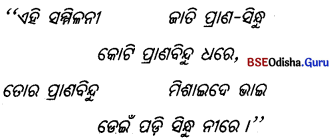
ଅଣାଯାଇ, ଓଡ଼ିଶା ସହିତ ମିଶାଇ ଦିଆଯାଇଥିଲା । ଆମେ ଆଜି ଯେଉଁ ସ୍ବତନ୍ତ୍ର ଉତ୍କଳ ପ୍ରଦେଶ ଦେଖୁଛୁ, ତାହା ମଧୁସୂଦନଙ୍କ କଟକରେ ଆଜି ଯେଉଁ ସୁନାରୁପାର ତାରକସି କାମ ଜଗତରେ ପ୍ରସିଦ୍ଧି ଲାଭ କରିଛି, ତାହା ସେହି ମଧୁସୂଦନଙ୍କ ବେକାର ଯୁବକଙ୍କୁ ନିଯୁକ୍ତି ଦେଇଥିଲେ । ଗୋଧ୍ ଚମଡ଼ା ଓ କୁମ୍ଭୀରି ଚମଡ଼ାରୁ ଯେ ଉତ୍କୃଷ୍ଟ ଜୋତା, ବ୍ୟାଗ୍ ତିଆରି ହୋଇପାରେ, ତାହା ମଧୁସୂଦନ ଚିନ୍ତା କରିଥିଲେ । ବ୍ୟବସାୟୀ ଭାବରେ ସେ ଉତ୍କଳ ଟାନେରୀ ଚଳାଇଥିଲେ ବହୁତ ଲାଭ ହୋଇଥାନ୍ତା, ମାତ୍ର ସେ ତାହା କରିନଥିଲେ । ତାଙ୍କର ଉଦ୍ଦେଶ୍ୟ ଥିଲା ଓଡ଼ିଶାର ନାମ ବଢୁ ।
ଓଡ଼ିଆ ଜାତି ଖରାପ ଜିନିଷ ତିଆରି କରୁଛି ବୋଲି କେହି ଯେପରି ନ କୁହନ୍ତି । ତେଣୁ ସେ ଚମଡ଼ା ବା ଜୋତାର ସାମାନ୍ୟ ଦୋଷ ଦେଖିଲେ ସେସବୁକୁ ସେ ନଷ୍ଟ କରି ଦେଉଥିଲେ । ଏଥିପାଇଁ ବ୍ୟବସାୟରେ ତାଙ୍କର ବହୁତ କ୍ଷତି ହୋଇଥିଲା । ଏହି ଟାନେରୀ ପାଇଁ ମଧୁବାବୁ ଋଣକରି ଦରିଦ୍ର ହୋଇ ଯାଇଥିଲେ । ଯେତେ ଯାହା ହେଲେବି ସେ କେବେହେଲେ, ନିଜର ଆତ୍ମସମ୍ମାନ ହରାଇନଥିଲେ । ସେ ସବୁବେଳେ କହୁଥିଲେ –
‘ଆଲୋ ସଖି, ଆପଣା ମହତ ଆପେ ରଖି ।’’
ନିର୍ବାଚିତ ହୋଇଥିଲେ । ସେ ମଧ୍ୟ ତାଙ୍କ ଜୀବନକାଳ ଭିତରେ ଦୁଇଥର ବିଲାତ ଯାଇଥିଲେ ଓ ସେଠାକାର ଶିକ୍ଷା, ସଭ୍ୟତା ଆଦି ତାଙ୍କୁ ବହୁ ଭାବରେ ପ୍ରଭାବିତ କରିଥିଲା । ୧୯୨୧ ମସିହାରେ ଯେତେବେଳେ ଆମ ଦେଶର ମନ୍ତ୍ରୀ ଶାସନ ପ୍ରତିଷ୍ଠା ହେଲା, ସେତେବେଳେ ବିହାର-ଓଡ଼ିଶା ପ୍ରଦେଶର ସେ ମନ୍ତ୍ରୀ ହୋଇଥିଲେ । ମନ୍ତ୍ରୀ ହିସାବରେ ସେ ନିଜର ଶକ୍ତି ଓ ସ୍ବାତନ୍ତ୍ର୍ୟ ବଜାୟ ରଖୁଥିଲେ । ଯେହେତୁ ମନ୍ତ୍ରୀମାନେ ଲୋକପ୍ରତିନିଧ୍ୟ, ସେଥିପାଇଁ ସେମାନେ ଅବୈତନିକ ଭାବରେ କାର୍ଯ୍ୟ କରିବା ଉଚିତ । ସରକାର ମଧୁବାବୁଙ୍କର ଏହି ମତକୁ ଗ୍ରହଣ କରିନଥିଲେ । ତେଣୁ ସେ ମନ୍ତ୍ରୀ ପଦରୁ ଇସ୍ତଫା ଦେଇଥିଲେ । ବ୍ୟବସ୍ଥାପକ ଥିବା ସମୟରେ ସେ ପ୍ରଜାସ୍ପଷ୍ଟ ଆଇନ, ବିହାର ଓଡ଼ିଶା ମ୍ୟୁନିସିପାଲ୍ଟ ଆଇନ ପ୍ରଣୟନ କରିଥିଲେ ।
ମଧୁସୂଦନ ଇଂରାଜୀ ଓ ଓଡ଼ିଆ ଭାଷାରେ ଜଣେ ତେଜସ୍ବୀ ବକ୍ତା ଥିଲେ । ଜାତି ସଂଗଠନ ପାଇଁ ସେ ଲୋକମାନଙ୍କୁ ପ୍ରୋତ୍ସାହିତ କରୁଥିଲେ । ସେ ସମୟରେ ଖଦିଲୁଗା ପିନ୍ଧିବା, କୃଷକ ସଭା ସ୍ଥାପନ କରିବା, ପ୍ରଜାପ୍ରତିନିଧୂ ସଙ୍ଗଠନ, ସ୍ଵଦେଶୀ ବସ୍ତ୍ର ନିର୍ମାଣ ଓ ପରିଧାନ ପାଇଁ ସେ ଦେଶବାସୀଙ୍କୁ ମତାଉଥିଲେ । ଜାତୀୟତାଭାବ ଜାଗରଣ ପାଇଁ ସେ ଉତ୍କଳ ସମ୍ମିଳନୀ ମଧୁସୂଦନଙ୍କ ମୃତ୍ୟୁର ଅଳ୍ପକାଳ ପୂର୍ବରୁ ଓଡ଼ିଶା ପ୍ରଦେଶ ଗଠନ ହେବାର ଘୋଷଣା ହୋଇଥିଲା । ଶାସନଗତ ପରିବର୍ତ୍ତନ ପାଇଁ ତହିଁର ବ୍ୟବସ୍ଥା ପାଇଁ ଯେଉଁ କମିଟି ଗଠନ କରାଯାଇଥିଲା, ମଧୁସୂଦନ ସେଥିର ସଦସ୍ୟ ଥିଲେ । ସାର୍ ଜନ୍. ହବାକ୍ (ଓଡ଼ିଶାର ପ୍ରଥମ ଗଭର୍ଣ୍ଣର) ସେହି କମିଟିର ଥିଲେ ସଭାପତି । ମାତ୍ର ଓଡ଼ିଶା ପ୍ରଦେଶ କମିଟି କାର୍ଯ୍ୟକାରୀ ହେବା ପୂର୍ବରୁ ମଧୁସୂଦନ ୮୬ ବର୍ଷ ବୟସରେ, ୧୯୩୪ ମସିହା ଫେବୃୟାରୀ ମାସ ୪ ତାରିଖରେ ଅମର ପଥର ଯାତ୍ରୀ ହୋଇଥିଲେ ।
ଯେହେତୁ ମଧୁସୂଦନ ଖ୍ରୀଷ୍ଟିୟାନ୍ ଧର୍ମ ଗ୍ରହଣ କରିଥିଲେ, ସେଥ୍ପାଇଁ କଟକର ମହାନଦୀ ତୀରବର୍ତୀ ଗୋରାକବର ହତା ମଧ୍ୟରେ ତାଙ୍କର ନଶ୍ବର ଦେହକୁ କବର ଦିଆଯାଇଥିଲା । ମଧୁସୂଦନଙ୍କ ସମ୍ପର୍କରେ ଲେଖକ ଶେଷରେ ଲେଖିଛନ୍ତି ‘ମଧୁସୂଦନଙ୍କ ନଶ୍ଵର ଦେହ ଆମ୍ଭମାନଙ୍କ ଚକ୍ଷୁରୁ ଅନ୍ତର୍ହିତ ହୋଇଅଛି ସତ୍ୟ; କିନ୍ତୁ ତାଙ୍କର ଅମର ଆତ୍ମା ଏ ଜାତିର ଗତିବିଧି ସର୍ବଦା ଲକ୍ଷ୍ୟ କରୁଅଛି । ତାଙ୍କର ପ୍ରଦର୍ଶିତ ପନ୍ଥା ଅନୁସରଣ କରି ଏ ଜାତି ଜଗତର ଅନ୍ୟାନ୍ୟ ସଭ୍ୟ ଜାତିର ସମକକ୍ଷ ହେଉ, ଏଥିପାଇଁ ଆମ୍ଭେମାନେ ତାଙ୍କ ଆଶୀର୍ବାଦ ଭିକ୍ଷା କରୁଅଛୁ ।’’
କଠିନ ଶବ୍ଦ ଓ ଏହାର ଅର୍ଥ :
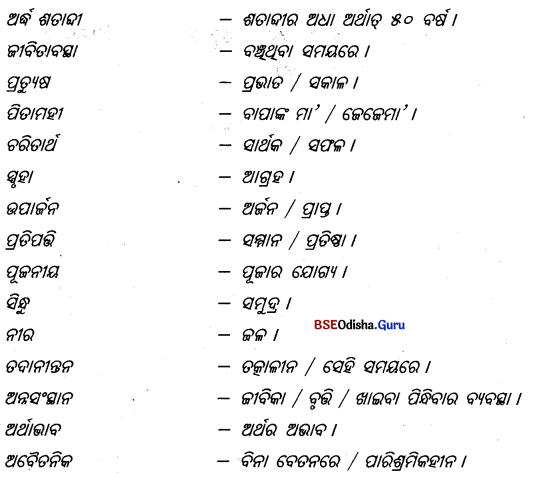
![]()
![]()
![]()
![]()
![]()
